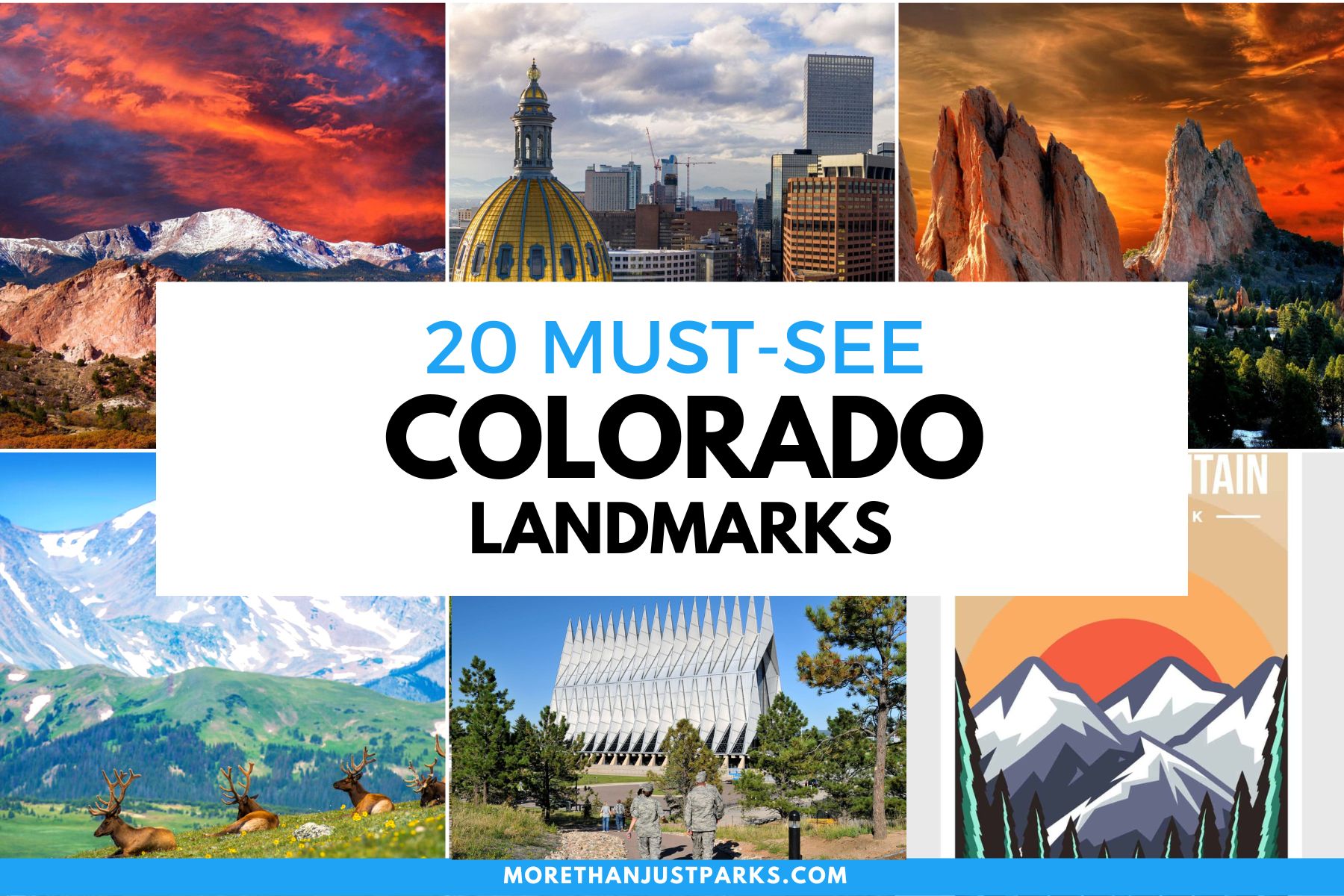
Article Summary: Colorado Landmarks
Colorado Landmarks. More Than Just Parks has 20 incredible must-see sites for you to visit.
There’s so much more to this exciting place than the Colorado Rockies. In this article, we’ll familiarize you with the incredible landmarks located in The Centennial State.
We’ve got incredible places, iconic memorials, fascinating museums, epic monuments and so much more.
We’re going to give you our list of the Top 20 Landmarks In Colorado.
So, What Is A Landmark?
Well, it’s a place of “a special character or special historical or aesthetic interest or value as part of the development, heritage, or cultural characteristics of a city, state, or nation.”
Why visit these places? Because landmarks connect us to the past. Through visiting these wonderful places where history occurred we find our roots. It allows us to feel like we are a part of something much bigger than ourselves.
And, speaking of history, did I mention that I taught the subject? I spent a lifetime teaching about the history behind many of these amazing sites. Then I got to see them firsthand. And now I’m sharing the fascinating stories of these places with you. It doesn’t get any better than that!
So, without further ado, let’s dive in.
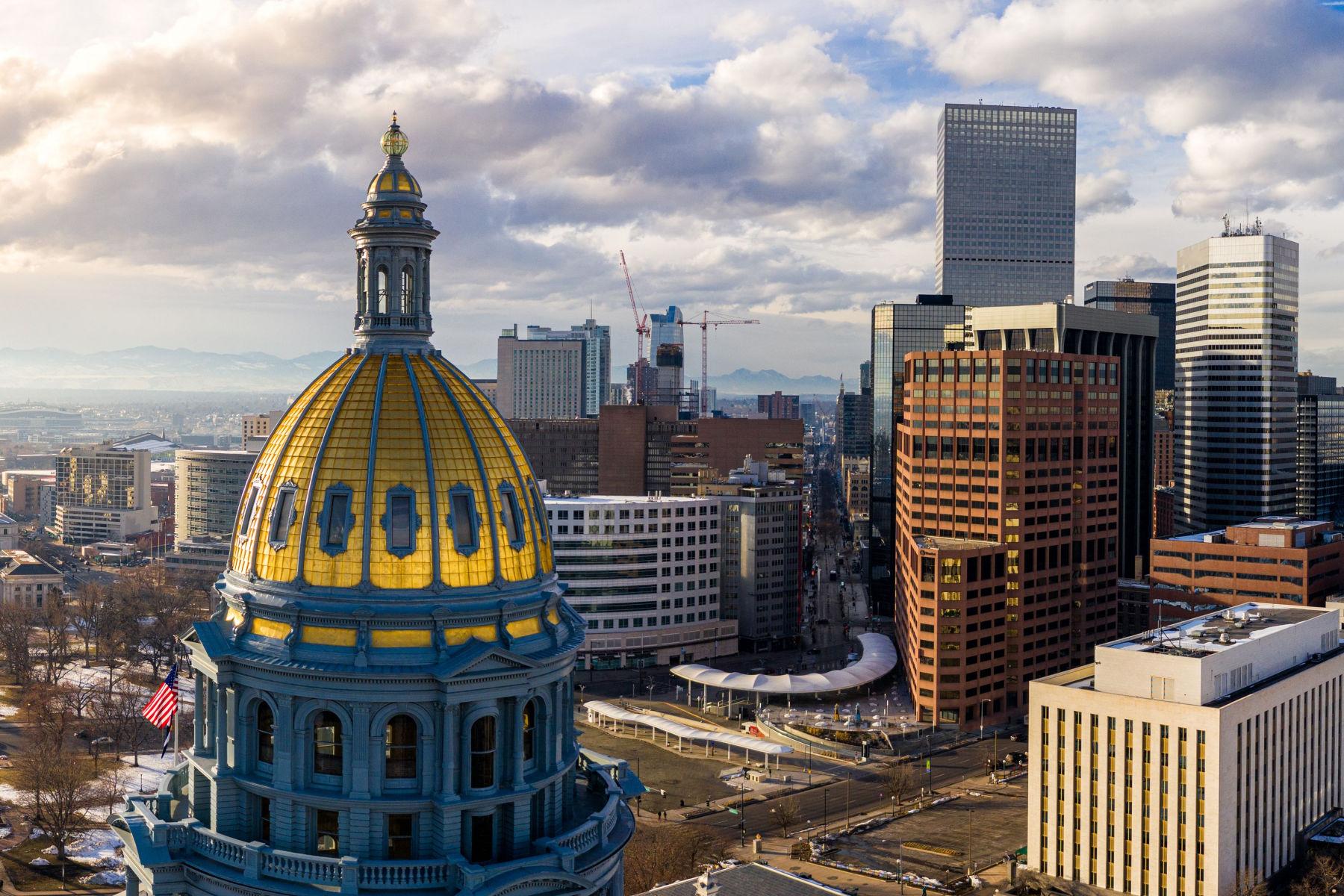
Table Of Contents
Colorado Landmarks
Some Fascinating Facts About Colorado
Here’s some fascinating facts about Colorado:
- Colorado is nicknamed the “Centennial State” because it became the 38th state to join the Union in 1876, 100 years after the signing of the Declaration of Independence.
- Colorado is the only state in the United States to have ever turned down the opportunity to host the Olympic Games. The city of Denver was originally awarded the 1976 Winter Olympics, but the voters rejected it due to concerns about pollution, costs, and the impact on the environment.
- The highest paved road in North America, the Mount Evans Scenic Byway, is located in Colorado. It reaches an elevation of 14,130 feet (4,307 meters) above sea level.
- Colorado has more than 300 days of sunshine per year, making it one of the sunniest states in the United States.
- Colorado is the only state in the United States to have a state song that was written by its citizens. “Where the Columbines Grow” was adopted as the official state song in 1915.
- The world’s first rodeo was held in Colorado in 1869 in Deer Trail. It was a competition between cowboys from several different ranches to determine who was the best at various cowboy skills.
- Colorado is home to the largest natural hot springs pool in the world, located in the town of Glenwood Springs. The pool covers over two blocks and contains over one million gallons of water.
- The famous inventor Thomas Edison once vacationed in Colorado and is rumored to have stayed in a cabin near the town of Breckenridge.
- The highest suspension bridge in the United States, the Royal Gorge Bridge, is located in Colorado. It spans 1,260 feet (384 meters) across the Arkansas River and is suspended 956 feet (291 meters) above the river.
- The state’s capital, Denver, is nicknamed the “Mile High City” because it is exactly one mile (5,280 feet or 1,609 meters) above sea level.

20. Ludlow Tent Colony Site
We’re kick off our list of the Best Colorado Landmarks at #20 with the Ludlow Tent Colony Site.
The Ludlow Massacre was a violent conflict that took place on April 20, 1914, in Ludlow, Colorado. The conflict arose from a strike by coal miners who were seeking better working conditions and wages from the coal companies.
The striking miners and their families were living in tents, and the Colorado National Guard was called in to restore order. The conflict escalated, and the National Guard attacked the tent colony, resulting in the deaths of two women, 11 children, and seven men.
The Ludlow Massacre is considered one of the most significant events in American labor history and is remembered as a tragedy that highlights the struggle of workers for fair treatment and decent working conditions.
The massacre had a lasting impact on the labor movement, and it led to the creation of new laws and regulations to protect the rights of workers.
Today, the site of the Ludlow Massacre is marked by a designated monument, and the event is remembered as a symbol of the struggle for justice and equality.

19. Indian Springs Trace Fossil Natural Area
Our next Colorado landmark is one of the best locations in North America to study trace fossils, due to the excellent preservation and diversity of fossil types, giving visitors a glimpse into the world long ago.
At #19 on our list of the Best Colorado Landmarks is Indian Springs Trace Fossil Natural Area.
Indian Springs Trace Fossil Natural Area is notable for its abundance of trace fossils, which are the preserved evidence of animal activity from millions of years ago.
The history of Indian Springs Trace Fossil Natural Area dates back to the Late Paleozoic Era, around 290-320 million years ago, when the area was covered by a shallow sea. Over time, sediment accumulated on the sea floor, burying the remains of animals and plants that lived in the area.
As the sediment compressed and solidified into rock, the remains of these organisms were preserved in the form of trace fossils. These trace fossils include footprints, burrows, and other marks left behind by animals as they moved or dug through the sediment.
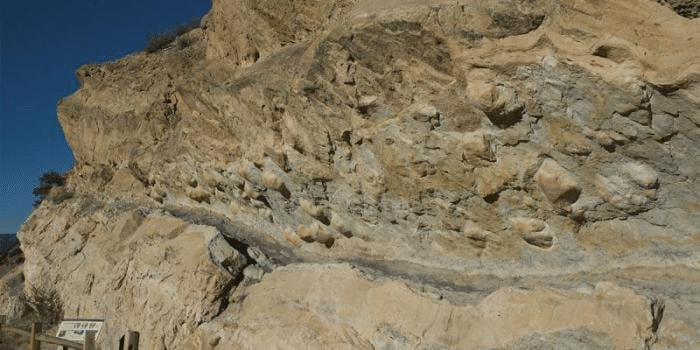
Indian Springs Trace Fossil Natural Area | Photo Courtesy of Uncover Colorado
Fossil Collectors Came To The Area
In the early 1900s, fossil collectors began to discover the rich deposits of trace fossils in the area. One of the most notable collectors was Harold W. Scott, a geologist who worked for the United States Geological Survey. Scott recognized the importance of the trace fossils in understanding the history of the area, and he began to map and study the fossil beds.
In the 1960s, the area was designated as a state natural area, and it was later acquired by the Bureau of Land Management.
Today, Indian Springs Trace Fossil Natural Area is open to the public, and visitors can explore the fossil beds and learn about the history of the area through interpretive signs and displays. The natural area is also a popular destination for fossil collectors, who can legally collect fossils from the area with a permit.
18. Shenandoah-Dives Mill
Our next landmark is a historic mill located in the town of Idaho Springs, Colorado. It was built in 1929 to process minerals mined from the surrounding area and is considered to be the only fully intact and functioning mill of its kind in the entire state of Colorado.
Welcome to the Shenandoah-Dives Mill, which is #18 on our list of the Best Colorado Landmarks.
The Shenandoah-Dives Mill was built during a period of rapid expansion in the mining industry in Colorado, as demand for minerals like silver, gold, copper, zinc, and lead grew. The mill was designed to extract these minerals from the ore mined in the area, using a variety of complex processes that involved grinding, crushing, and chemical treatments.
Over the years, the Shenandoah-Dives Mill played a critical role in the development of the mining industry in Colorado, and was considered to be one of the most technologically advanced mills of its time. The mill operated continuously until the 1940s, when mining operations in the area began to decline.
In the years that followed, the Shenandoah-Dives Mill was largely forgotten, but it was rediscovered and restored in the 1980s, and is now open to the public as a museum. Visitors can take guided tours of the mill, see the equipment and machinery in action, and learn about the history of the mill and the mining industry in Colorado.
The Shenandoah-Dives Mill is a unique and fascinating piece of American industrial history, and is well worth a visit for anyone interested in the history of mining and the American West.

17. Durango & Silverton Narrow Gauge Railroad
Our next Colorado landmark is one of the most popular heritage railroads in North America. It offers a unique, affordable, family-friendly travel experience that combines Colorado’s colorful pioneering and mining histories with unparalleled backcountry beauty.
At #17 on our list of the Best Colorado Landmarks is the Durango & Silverton Narrow Gauge Railroad.

The Railroad Survived Many Difficulties
Despite challenges including floods, fires, and financial difficulties, the Durango & Silverton Narrow Gauge Railroad continued to operate through the 20th century. In the 1980s, the railroad was designated a National Historic Landmark, recognizing its historic significance and the importance of its preservation.
Today, the Durango & Silverton Narrow Gauge Railroad is a popular tourist attraction, drawing visitors from around the world to experience the scenic beauty of the San Juan Mountains and to travel back in time to the days of the Old West.
The railroad operates daily throughout the summer and fall, offering a variety of excursion trains and special events. It also maintains a museum and other facilities in Durango, providing visitors with an opportunity to learn about the history of the railroad and the role it played in the development of the American West.

16. Molly Brown House Museum
At #16 on our list of the Best Colorado Landmarks is a place which is dedicated to the life and legacy of a prominent social activist and philanthropist of the late 19th and early 20th centuries. She may be best known, however, for being “unsinkable.” Welcome to the Molly Brown House Museum.
The Molly Brown House Museum is located in Denver, Colorado. The history of the house dates back to the late 1800s, when it was built by a prominent Denver architect named William Lang.
Margaret Brown and her husband, James Joseph Brown, purchased the house in 1894 and lived there for many years. During this time, Margaret became involved in a variety of social causes, including women’s suffrage, labor rights, and disaster relief.

She Gained Fame For Her Actions On The Titanic
She also gained fame for her heroic actions during the sinking of the Titanic in 1912, where she helped to organize the evacuation of passengers and worked to secure funding for the survivors.
After the death of her husband in 1922, Margaret Brown continued to live in the house until her death in 1932. In the years that followed, the house was used for a variety of purposes, including as a boarding house and a music conservatory.
In the 1970s, the house was slated for demolition, but a group of concerned citizens rallied to save it and restore it as a museum dedicated to the life of Margaret Brown. The museum opened to the public in 1971 and has since become one of Denver’s most popular cultural attractions.
Today, the Molly Brown House Museum offers visitors a glimpse into the life and times of Margaret Brown and the social and cultural movements of the early 20th century. The museum features exhibits on women’s suffrage, labor rights, and the Titanic disaster, as well as a collection of artifacts and personal belongings from the Brown family.

Top 15 Colorado Landmarks
15. Hovenweep National Monument
We’re moving on to our Top 15 Colorado Landmarks. If you enjoy the ancient past then you’ll love our next site. At #15 on our list of the Best Colorado Landmarks is the Hovenweep National Monument.
Hovenweep National Monument is located in the southwestern United States, straddling the border between Colorado and Utah. The history of the area dates back thousands of years, to the time of the Ancestral Puebloan people who lived in the region from around AD 500 to 1300.
The Ancestral Puebloans built a complex system of stone structures in the Hovenweep area, including towers, kivas (ceremonial structures), and dwellings. These structures were built using local sandstone blocks and show evidence of skilled masonry and engineering.
The history of Hovenweep as a national monument began in the early 20th century, when a group of archaeologists and preservationists recognized the significance of the area and began lobbying for its protection.
In 1923, President Warren G. Harding designated Hovenweep a national monument, protecting the area for future generations and recognizing its historic and cultural significance.
Since that time, the National Park Service has been responsible for managing and preserving the Hovenweep National Monument, working to protect the archaeological resources of the area and to promote public awareness and appreciation of its rich history.
Today, Hovenweep National Monument is a popular destination for visitors interested in exploring the history and culture of the Ancestral Puebloans.
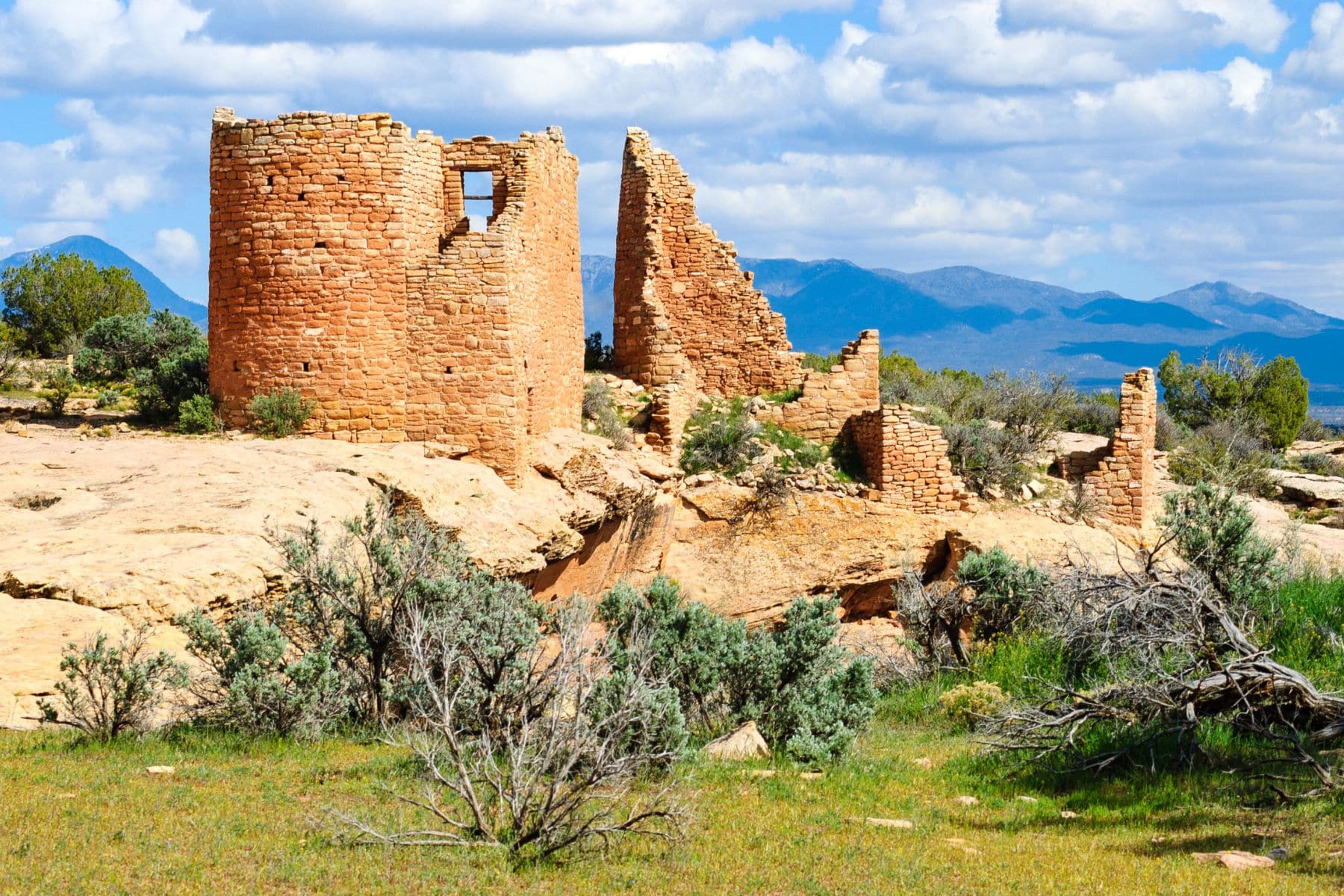
14. Philadelphia Toboggan Company Carousel No. 6
Our next Colorado landmark’s carved wooden animals and oil paintings make it a beautiful work of art. It is the only carousel in the country with original paint on its animals and paintings.
At #14 on our list of the Best Colorado Landmarks is Philadelphia Toboggan Company Carousel No. 6.
The carousel was built by the Philadelphia Toboggan Company, one of the leading manufacturers of carousels and other amusement park attractions in the early 20th century. It was built in 1905 and is one of only a few antique carousels still in operation today.
Philadelphia Toboggan Company Carousel No. 6 is notable for its hand-carved wooden horses and other figures, which were created by skilled craftsmen using traditional techniques.
The carousel features a menagerie of horses, cats, rabbits, and other creatures, as well as a Wurlitzer military band organ that provides live music. The carousel has been well-preserved and is considered a treasure of American folk art.
Today, Philadelphia Toboggan Company Carousel No. 6 continues to operate as a popular attraction at Elitch Gardens. It is a beloved piece of Denver’s cultural heritage and a symbol of the city’s long history of innovation and creativity.
The carousel is a protected National Historic Landmark and is considered one of the most important examples of antique carousels in the United States.

13. Bent’s Old Fort National Historic Site
Another amazing landmark in Colorado is Bent’s Old Fort National Historic Site. And it’s #13 on our list of the Best Colorado Landmarks.
According to the National Park Service, this site features a reconstructed 1840s adobe fur trading post on the mountain branch of the Santa Fe Trail where traders, trappers, travelers, and the Cheyenne and Arapaho tribes came together in peaceful terms for trade.
William and Charles Bent, along with Ceran St. Vrain, built the original adobe fort on this site in 1833 to trade with Plains Indians and trappers.
The fort quickly became the center of the expanding holdings of Bent, St. Vrain & Company, including Fort St. Vrain to the north and Fort Adobe to the south, along with company stores in Taos and Santa Fe. The primary trade was with the Southern Cheyenne and Arapaho Indians for buffalo robes.

The Only Major Permanent Settlement On The Santa Fe Trail
For much of its 16-year history, the fort was the only major permanent white settlement on the Santa Fe Trail between Missouri and the Mexican settlements.
The fort provided explorers, adventurers, and the U.S. Army a place to get needed supplies, wagon repairs, livestock, good food, water and company, rest and protection in this vast “Great American Desert.”
During the war with Mexico in 1846, the fort became a staging area for Colonel Stephen Watts Kearny’s “Army of the West.” Disasters and disease caused the fort’s abandonment in 1849. (Source: NPS)

Step Back In Time
Today visitors can step back in time and take a self-guided tour of the fort and discover the role the fort played in opening the west.
Archeological excavations and original sketches, paintings, and diaries were used to replicate the features of the fort, which was reconstructed during the country’s bicentennial and Colorado’s centennial in 1976.
The architecturally accurate, reconstructed fort and its historic setting allow visitors to “step back” in time to learn about and reflect on the westward expansion of the United States.
Interpreters dressed in period clothing are available to answer any questions.

12. Florissant Fossil Beds National Monument
Our next site is truly a geologic wonder. At #12 on our list of the Best Colorado Landmarks is the Florissant Fossil Beds National Monument.
Petrified redwood stumps up to 14 feet wide and thousands of detailed fossils of insects and plants reveal the story of a very different, prehistoric Colorado.
This incredible site features some amazing self guided hikes. Three of my favorites are:
- Petrified Forest Loop: This 1.1 mile self-guided trail leads through the beds of ancient Lake Florissant. It passes numerous giant petrified redwood tree stumps, including the colorful “Big Stump”. This trail starts behind the outdoor exhibit area.
- Geologic Trail: This .6 mile (one way) self-guided trail highlights over a billion years of geologic history in the Florissant Valley. It passes over the ancient lake bed, crosses Teller County Rd. 1, then ascends past the remnants of a massive pyroclastic flow and ends at a scenic overview of the Florissant valley.
- Ponderosa Loop: This is a .4 mile wheelchair accessible trail which starts behind the exhibit area. It’s self-guided and enters the modern forest of ponderosa pines, aspen, douglas fir, and spruce trees. (Source: NPS)
If you’re looking for a longer hike there are over 14 miles of hiking trails in the Monument.
Most of the trails wind through pine covered hills with patches of Aspen and Douglas Fir. Some of the trails pass wet meadows or through riparian areas.

11. Red Rocks Park and Amphitheater
Our next Colorado landmark is a naturally formed, world-famous outdoor venue just fifteen miles west of Denver. It’s recognized for its star-studded concert roster, natural acoustics and ambience, as well as its awe-inspiring hiking and biking trails.
At #11 on our list of the Best Colorado Landmarks is Red Rocks Park and Amphitheater.
The history of Red Rocks Park dates back to the late 1800s, when the area was first discovered by settlers. The towering red sandstone formations that give the park its name were formed over millions of years by the erosion of the surrounding rock, creating a dramatic natural amphitheater that was ideal for outdoor concerts and performances.
In the early 1900s, local entrepreneur John Brisben Walker recognized the potential of the area as a concert venue and began to host events at Red Rocks. In 1910, he built the first permanent seating structure, a simple wooden bench that could hold a few hundred people.
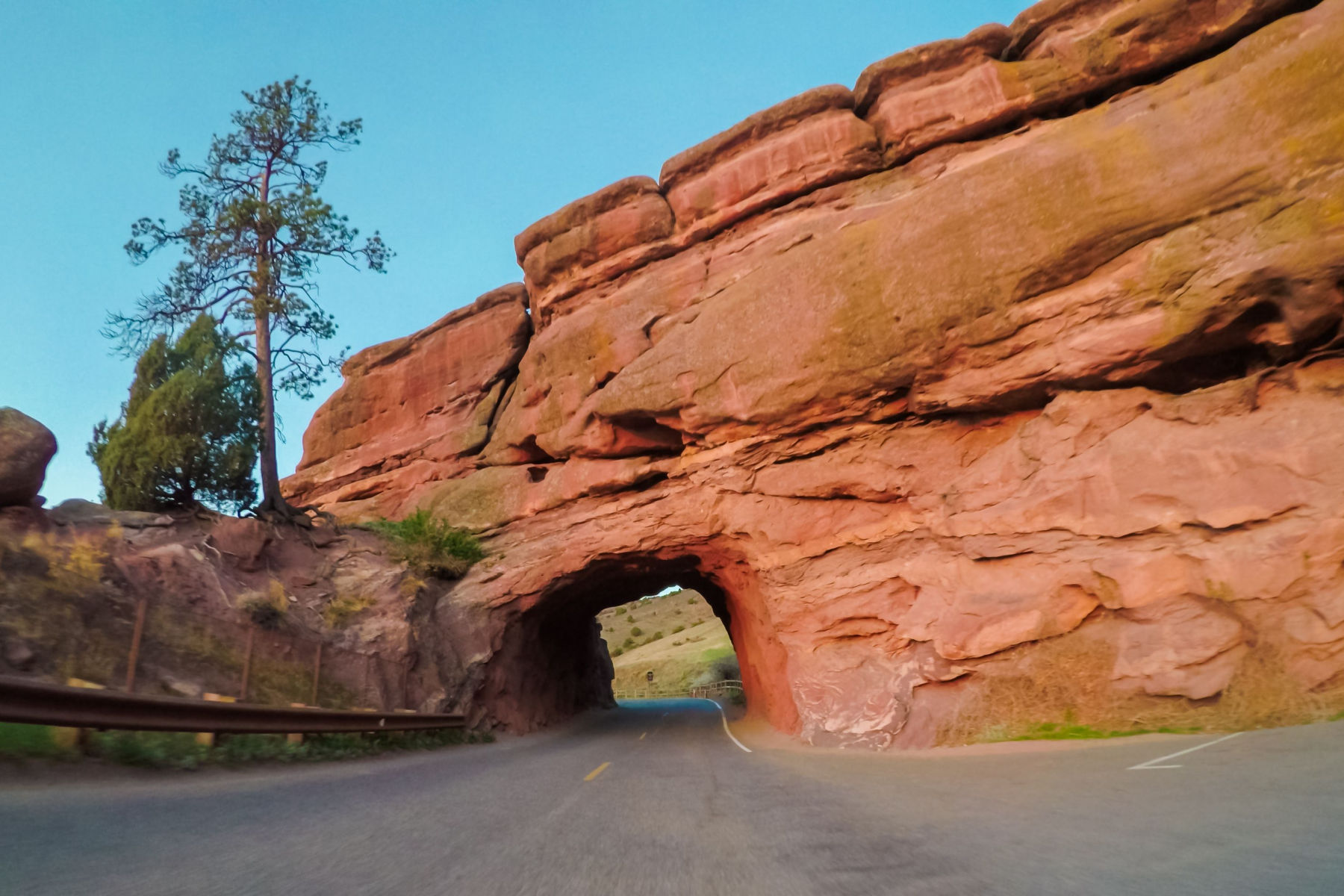
Red Rocks Continued To Grow & Evolve
Over the years, Red Rocks Park and Amphitheater continued to grow and evolve. In the 1920s, the Civilian Conservation Corps built trails and roads throughout the park, making it more accessible to visitors.
In the 1930s, the Works Progress Administration built the famous amphitheater, using the natural contours of the landscape to create a stunning, acoustically perfect venue.
Throughout the 20th century, Red Rocks Park and Amphitheater became a beloved cultural landmark, hosting countless concerts and events by some of the world’s most famous musicians. Performers such as The Beatles, U2, and Bruce Springsteen have all graced the stage at Red Rocks, cementing its place in musical history.
Today, Red Rocks Park and Amphitheater remains a popular destination for music lovers and outdoor enthusiasts alike. Visitors can hike or bike the park’s many trails, take in stunning views of the surrounding mountains, and experience live music in one of the most unique and iconic venues in the world.
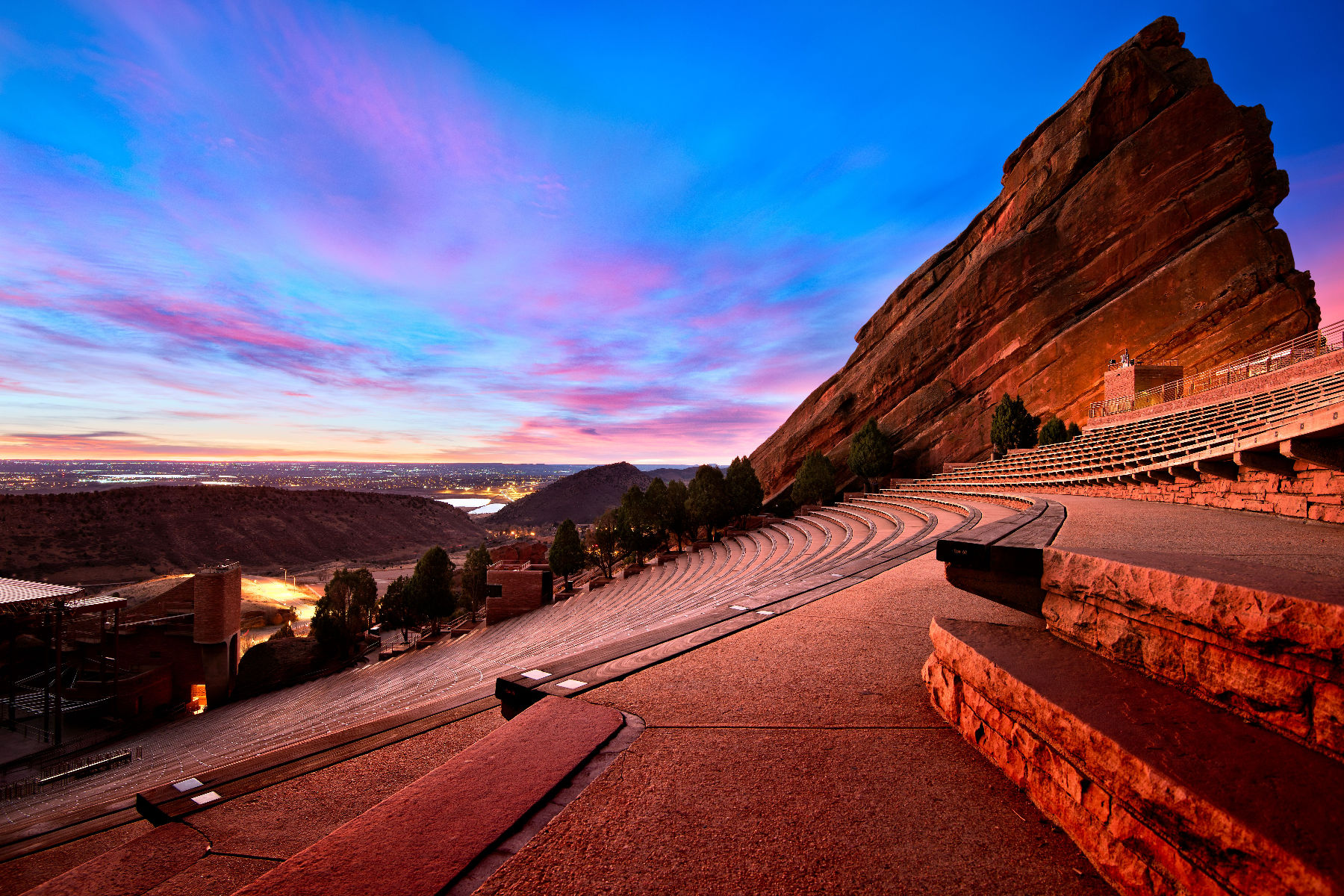
Top 10 Colorado Landmarks
10. Canyon of the Ancients National Monument
We’re on to our Top 10 Colorado Landmarks. At #10 is a place which contains the highest known archaeological site density in the United States, with rich well-preserved evidence of Native American cultures. The archeological record etched into this landscape is much more than isolated islands of architecture.
Welcome to Canyon of the Ancients National Monument.
The monument covers over 170,000 acres of rugged terrain, including canyons, mesas, and high desert landscapes. It is home to one of the largest concentrations of archaeological sites in the United States.
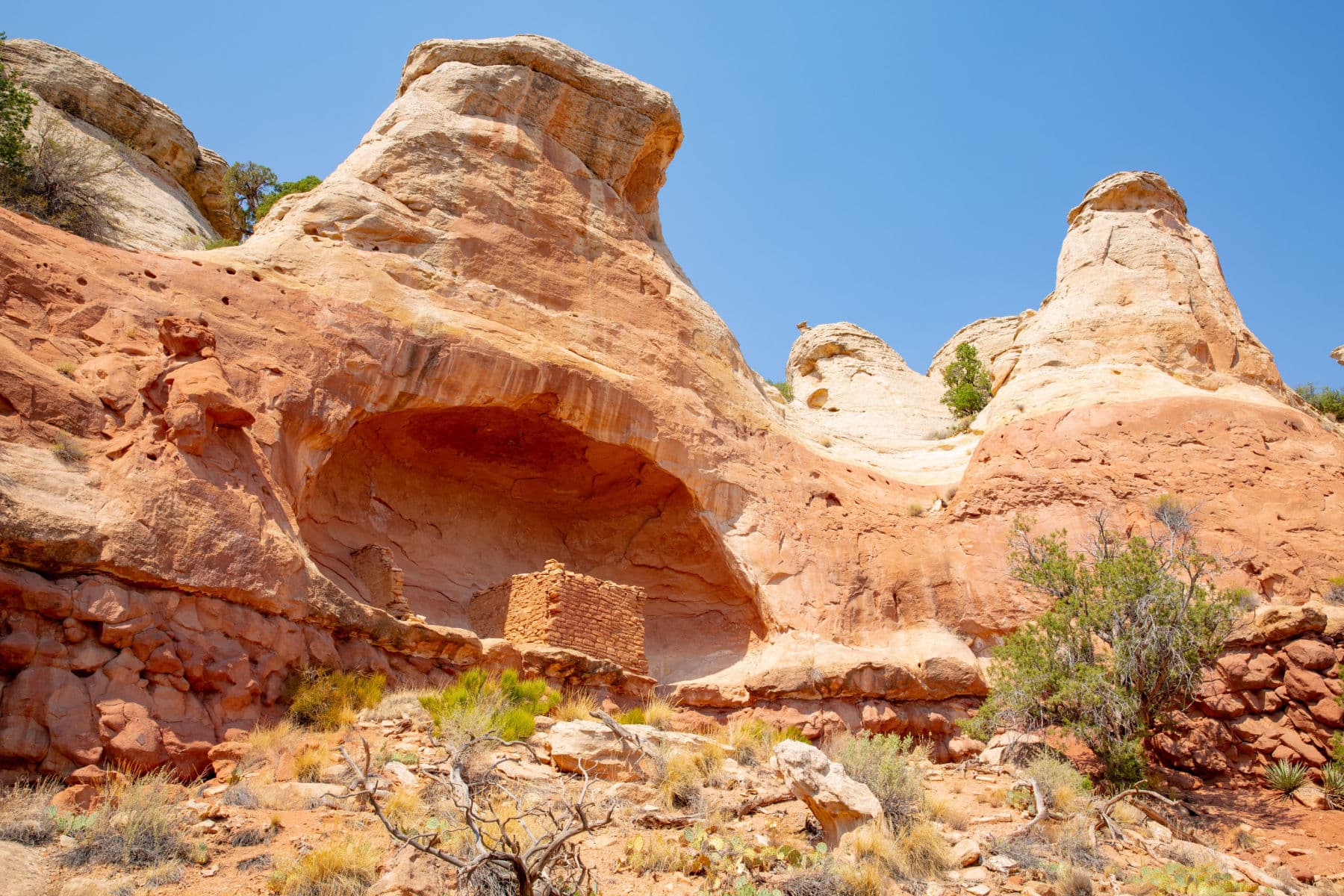
The History Of The Monument
The history of Canyon of the Ancients National Monument dates back thousands of years, to a time when ancient cultures inhabited the region. These cultures left behind a rich legacy of artifacts, dwellings, and other archaeological sites that provide a glimpse into their way of life.
The first recorded exploration of the area was conducted by Europeans in the late 1700s and early 1800s. In the decades that followed, the region became a popular destination for settlers and miners, who were drawn to the area by the prospect of gold and other resources.
Throughout the 20th century, archaeologists began to study the region in earnest, uncovering a vast network of ancient sites that spanned thousands of years of human history. These sites include dwellings, pit houses, kivas, granaries, and other structures, as well as rock art, pottery, and other artifacts.
In 2000, Canyon of the Ancients National Monument was established by presidential proclamation, in order to protect and preserve the rich archaeological heritage of the region.
Today, the monument is managed by the Bureau of Land Management, and visitors can explore the many archaeological sites and learn about the region’s ancient cultures through interpretive exhibits and programs.
Canyon of the Ancients National Monument is an important reminder of the rich cultural history of the American Southwest, and a testament to the resilience and ingenuity of the ancient peoples who once called the region home.
9. Sand Creek Massacre National Historic Site
Our next site marks the location of an infamous chapter in American history. It’s a must-see for anyone interested in the history of the American West. At #9 is the Sand Creek Massacre National Historic Site.
The Sand Creek Massacre National Historic Site is a memorial and historic site located in southeastern Colorado. It marks the location of the Sand Creek Massacre, which took place on November 29, 1864.
The massacre was a brutal attack on a peaceful Cheyenne and Arapaho village by the Colorado Volunteer Cavalry, and it resulted in the deaths of hundreds of Native American men, women, and children.
The Sand Creek Massacre had a profound and lasting impact on the Cheyenne and Arapaho people, and it remains a source of deep pain and trauma for their descendants.
The massacre was one of the darkest moments in American history, and it serves as a reminder of the violence and injustice that was inflicted upon Native American communities in the West.

Established To Commemorate The Lives That Were Lost
It was established in 2007 to commemorate the lives lost and to provide a place for reflection, education, and healing.
The site features a memorial plaza, a visitors center, and several walking trails that offer visitors the opportunity to learn about the history of the massacre and its aftermath. The site is managed by the National Park Service, and it is a protected National Historic Landmark.
The Sand Creek Massacre National Historic Site is an important part of America’s cultural heritage, and it serves as a reminder of the need for reconciliation and understanding between different cultures and communities.
The site offers a powerful lesson about the consequences of violence and hatred, and it is a symbol of hope and resilience for future generations.

Take A Deeper Dive
To learn more, I recommend Sand Creek Massacre by Stan Hoig. This account of the massacre investigates the historical events leading to the battle, tracing the growth of the Indian-white conflict in Colorado Territory.
The author has shown the way in which the discontent stemming from the treaty of Fort Wise, the depredations committed by the Cheyennes and Arapahoes prior to the massacre, and the desire of some of the commanding officers for a bloody victory against the Indians laid the groundwork for the battle at Sand Creek.
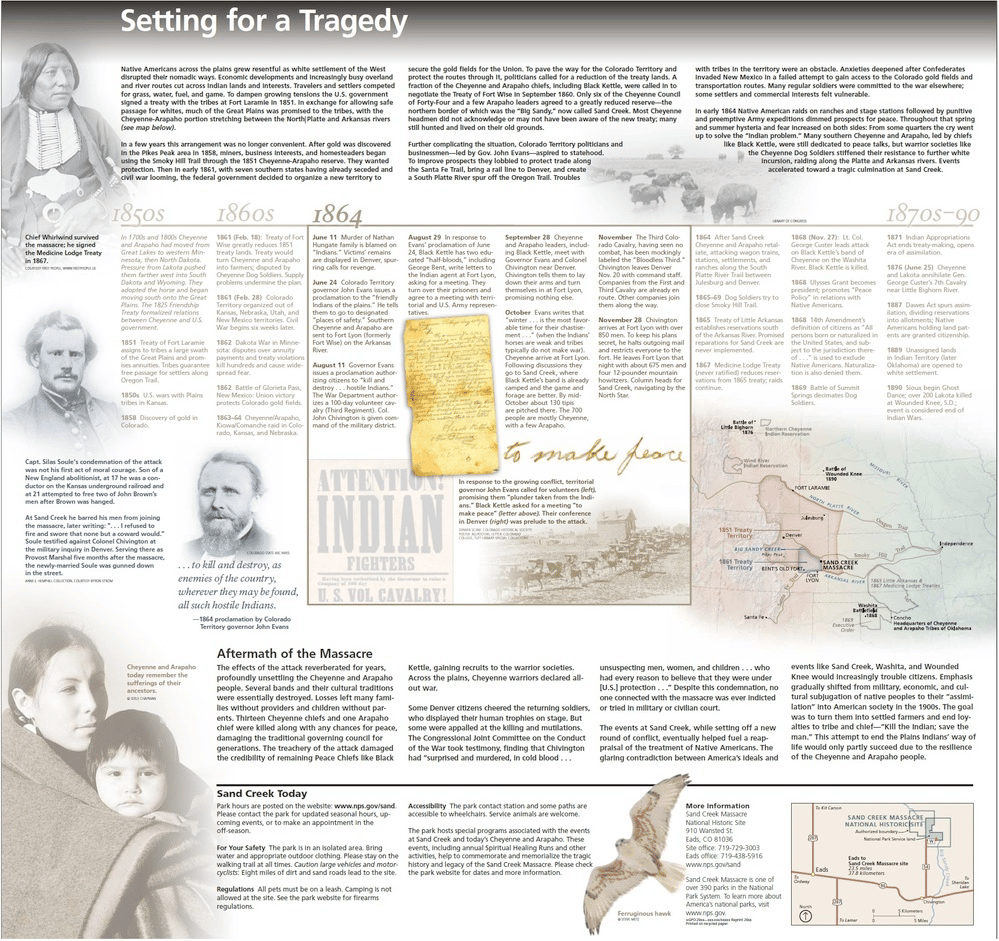
What To See At Sand Creek
The site is on the grassland plains of southeast Colorado and remains largely undeveloped, but offers a visitor picnic area and visitor contact station with bookstore. Visitors can access the national historic site via a county road off Colorado State Highway 96.
The Monument Hill area includes an overlook above Big Sandy Creek, a shade structure, and the Repatriation Area. A primitive trail continues along the bluff beyond the Monument Hill overlook, overlooking the creek bed and following the course of the massacre as tribal members fled along the creek with soldiers in pursuit.
A number of interim interpretive wayside exhibits provide visitors with information about the massacre. Visitor information is also provided by a ranger-led interpretive program, a park brochure, site bulletins, and other printed material.

8. Dinosaur National Monument
At #8 is a hidden gem which straddles the remote northern corners of two states, Colorado & Utah. Welcome to Dinosaur National Monument.
The common refrain here is that if you’re interested in dinosaurs you’ll love this monument – which is true, but it vastly undersells this sprawling and immensely beautiful monument because it’s much more than that.
In addition to the famous dinosaur quarry and countless immaculately preserved dinosaur bones and skulls from various species, the park is home to over 200,000 acres of outdoor grandeur.
Here you can peer into the depths of stunning red rock canyons, whitewater raft the world-class Green or Yampa rivers, explore historic cabins and ponder ancient petroglyphs, camp out under a star-studded sky, and of course hike numerous trails venturing into the rugged and beautiful surroundings.
And while you’re there be sure to check out the Quarry Exhibit Hall which allows visitors to view the wall of approximately 1,500 dinosaur bones in a refurbished, comfortable space.

7. Granada War Relocation Center
Our next Colorado landmark was one of ten incarceration sites established by the War Relocation Authority during World War II to unjustly incarcerate Japanese Americans. Over 10,000 people, most American citizens, were incarcerated at Amache from 1942-1945.
On our list of the Best Colorado Landmarks at #7 is the Granada War Relocation Center.
To set the stage for this important site, a brief history lesson is in order.
After Japan’s attack on Pearl Harbor, on December 7, 1941, led to the United States’ entry into World War Two, President Franklin D. Roosevelt signed Executive Order 9066 on February 19, 1942.
The Order authorized the establishment of military areas encompassing most of the West Coast of the United States, “from which any or all persons may be excluded.”
This allowed for the removal from these areas of Japanese Americans and those of Japanese ancestry, out of fear that they might support Japan in the war.

Executive Order #9102
In March 1942, President Roosevelt signed Executive Order 9102, which established the War Relocation Authority (WRA), the federal agency responsible for the evacuation, relocation, and internment of Japanese Americans and the construction and administration of relocation centers throughout the United States.
In 1942, an area in southeastern Colorado was selected as a relocation center camp site by the WRA.
Governor Ralph L. Carr of Colorado had been the only western governor to welcome evacuees in his state, volunteering Colorado for a relocation center and urging acceptance and understanding for Japanese Americans.
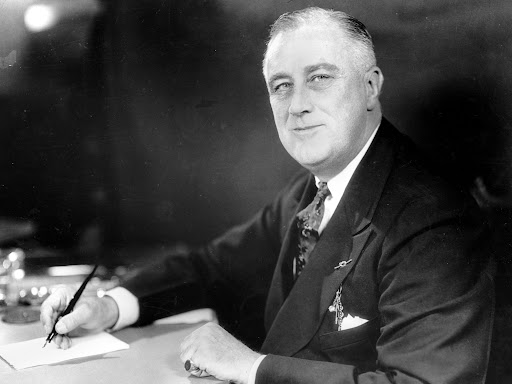
Camp Amache
Camp Amache had been under construction for only two months when it received its first 212 evacuees on August 27, 1942. Even though the center was not complete, 15 groups of evacuees moved into Amache over a three month period.
By the end of October, Camp Amache had over 7,300 internees. The first winter at the center was particularly hard as most of the internees were from California and had no heavy clothing. A family consisting of seven or fewer members was assigned to one cramped room measuring 20 by 24 feet.
The internees were allowed to decorate the rooms and attempted to make them as homelike as possible with shelves, partitions, and crude furniture made from scrap wood.
While Camp Amache was the smallest of the 10 relocation centers, it was the tenth largest city in Colorado, and more than 10,000 people eventually passed through the center before it closed in 1945.

Things To Do
Today, the former site of the Granada War Relocation Center includes a museum and interpretive center dedicated to preserving the history of the camp and the experiences of those who were interned there. The site also features walking trails, interpretive signs, and memorials that commemorate the lives and stories of the Japanese Americans who were held at the camp.
Visitors to the Amache Historic Site can learn about the history of the Granada War Relocation Center, the internment of Japanese Americans during World War II, and the broader context of racial prejudice and discrimination in American history.
The site offers a powerful lesson about the importance of civil rights and the need to protect the constitutional rights of all Americans, regardless of race or ethnicity.

Take A Deeper Dive
To learn more about this tragic chapter of American history I recommend: Infamy: The Shocking Story of the Japanese American Internment in World War II.
Acclaimed historian Richard Reeves has interviewed survivors, read numerous private letters and memoirs, and combed through archives to deliver a sweeping narrative of this atrocity.
6. Great Sand Dunes National Park and Preserve
Our next Colorado landmark protects the tallest sand dunes in North America, with the legendary Star Dune towering at 755 feet. At #6 on our list of the Best Colorado Landmarks is the Great Sand Dunes National Park and Preserve.
The park covers an area of 150,000 acres and includes the tallest sand dunes in North America, with the tallest peak reaching up to 750 feet high. The park is situated at the base of the Sangre de Cristo Mountains and is known for its unique geological features, which include the dunes, wetlands, grasslands, forests, and alpine tundra.
The dunes were formed over millions of years from sand deposits left behind by rivers and lakes. The constant wind blowing through the San Luis Valley causes the sand to be pushed up against the Sangre de Cristo Mountains, forming the towering dunes that can be seen today.

In addition to the dunes, the park is also home to a diverse range of wildlife, including black bears, mountain lions, bighorn sheep, and pronghorn antelope. Visitors can explore the park by hiking on the dunes, taking a scenic drive through the park, or participating in ranger-led programs that offer insight into the park’s ecology, geology, and history.
Great Sand Dunes National Park and Preserve is a popular destination for outdoor enthusiasts, including hikers, campers, and photographers. It offers a unique and breathtaking landscape that is unlike anything else in the United States.

Great Sand Dunes National Park & Preserve
Top 5 Colorado Landmarks
5. United States Air Force Academy
We’re on to the Top 5! At #5 is a site that’s definitely worth seeing especially if you enjoy military history. It’s the Unites States Air Force Academy.
The United States Air Force Academy (USAFA) is a military academy located in Colorado Springs, Colorado. It was established in 1954 as the first military academy dedicated solely to training officers for the United States Air Force (USAF).
The establishment of the USAFA was part of a broader effort by the USAF to modernize and professionalize its officer corps after World War II. The academy was designed to provide rigorous academic, physical, and military training to prepare young men and women to become officers in the USAF.
The USAFA has a rich history of producing some of the finest military officers and leaders in the United States. Cadets at the academy receive a rigorous education in the liberal arts, engineering, and the sciences, as well as extensive training in military tactics and leadership.
The academy’s curriculum is designed to prepare cadets for careers as commissioned officers in the USAF, and to instill in them the values of service, duty, and integrity.
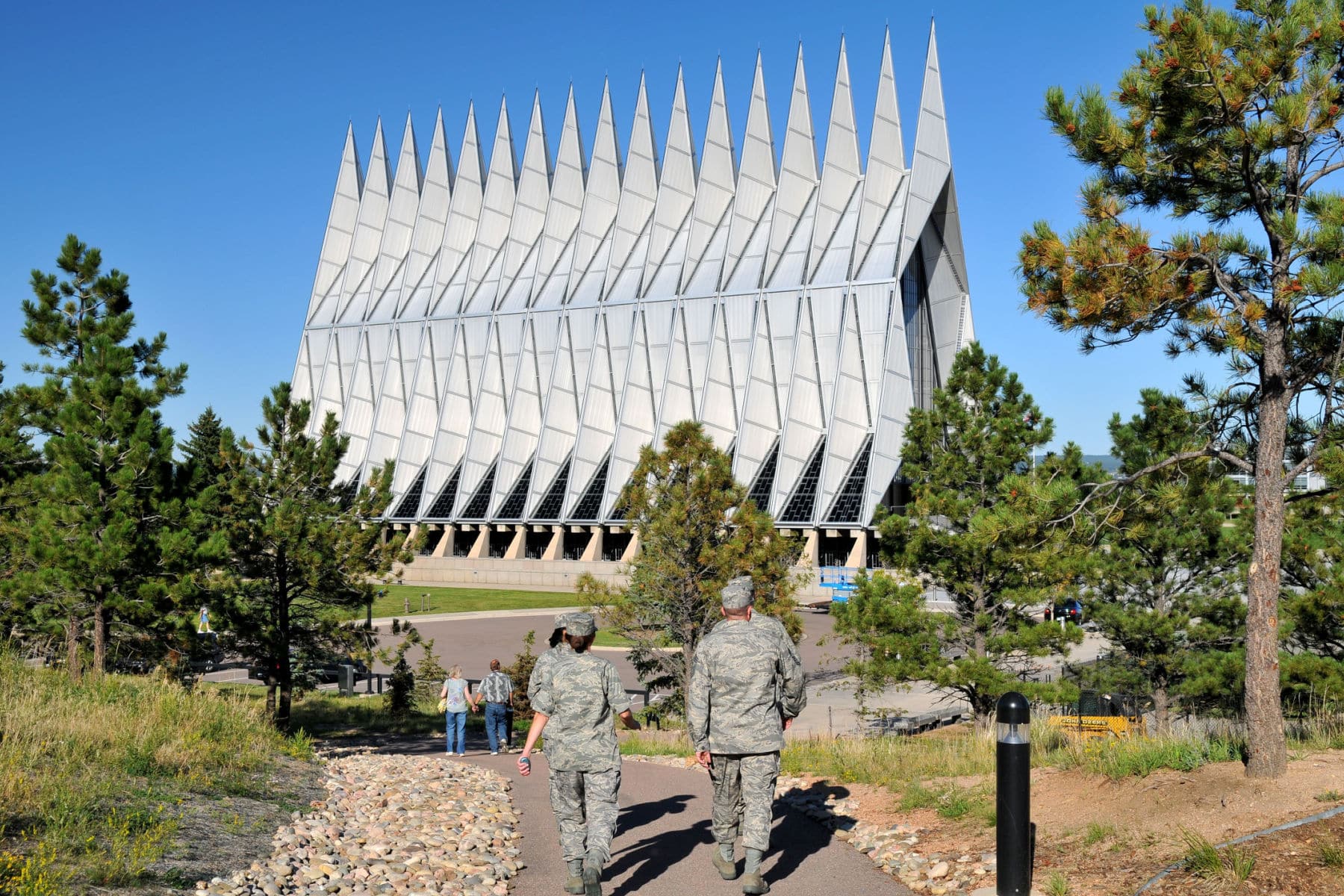
The Most Controversial Event
The most controversial event in the Academy’s history was the admission of women.
President Gerald R. Ford signed legislation Oct. 7, 1975, permitting women to enter the military academies. Women first entered the Air Force Academy June 28, 1976.
The first class including women graduated in 1980 and included the Academy’s first woman to be superintendent, retired Lt. Gen. Michelle Johnson.

The Top 6 Attractions At The Air Force Academy
A visit to the U.S. Air Force Academy is truly worth it. There are so many wonderful things to see and do. Here’s our Pick Six:
- Cadet Chapel: It encompasses the beauty of midcentury-modern architecture with inspiration from Air Force vessels. With stained glass symbols and historical accents, each congregation center has its own beauty.
- Chapel Overlook: It offers visitors great view of the Cadet Area. For a special treat, arrive just before noon and watch the orchestrated cadet lunch formation.
- The B-52 Display: All visitors must access the base through the north gate, this display will be hard to miss. This authentic B-52 bomber is truly awe inspiring.
- Cadet Field House & Falcon Athletic Center: It’s a mega-sized sports arena is home to Clune Arena (basketball), ice rink and indoor track.
- Barry Goldwater Visitor Center: The visitor center hosts exhibits of the campus and a mock cadet dorm room. The visitor center also has a short movie showing everyday cadet life, complete with a snippet of the graduation hat toss and Thunderbird flyover.
- USAFA Planetarium: It’s a state-of-the-art facility with reclining seats, inter-connectivity with planetariums around the world and a live feed from the largest publicly accessed telescope in Colorado, also accessible at the Academy’s Observatory.

4. Black Canyon of the Gunnison National Park
When people think about a national park they don’t always thing about its history. Often, it’s nature and recreational activities which are uppermost on peoples minds.
At #4 on our list of the Best Colorado Landmarks is just such a place. Welcome to the Black Canyon Of The Gunnison National Park. It’s more than just a park!
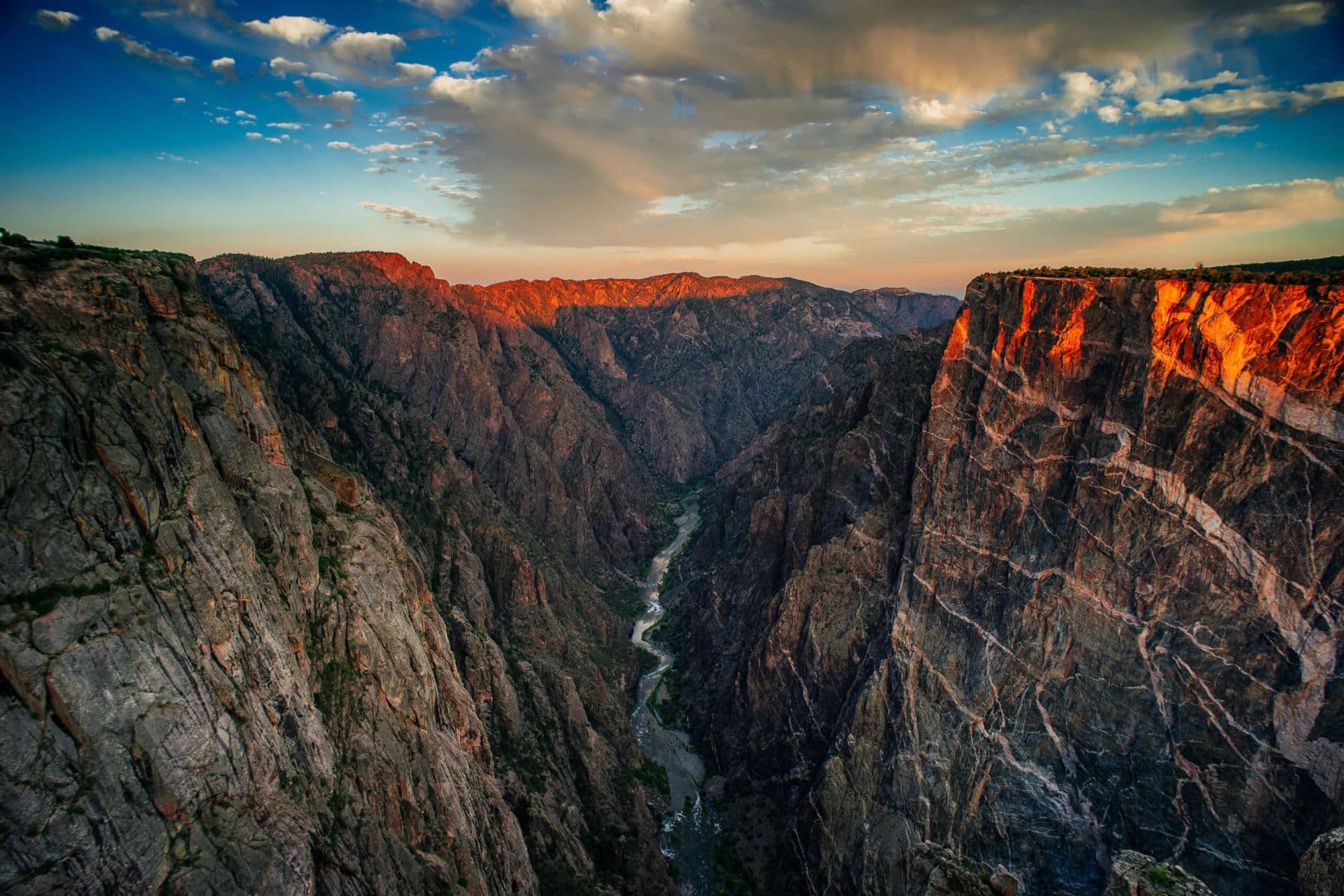
John Williams Gunnison was a West Point graduate. In 1853, he would lead an expedition into the canyon which became his claim to fame.
Gunnison spent much of his life exploring new lands. He and his survey crew mapped much of the border land and the shores of Lake Michigan. Later he explored and mapped the Great Salt Lake region and gathered scientific information about their surroundings.
According to the National Park Service, Lieutenant Gunnison was promoted to Captain on March 3, 1853 largely due to his successes in Utah and the Great Lakes region. Gunnison longed to begin a new adventure and to return to the Western United States that he had come to love. He would get his chance.
On September 7th, 1853, the Gunnison Expedition first glimpsed the relatively tame section of the Black Canyon at Lake Fork. The report of the expedition described the area as “a stream imbedded in [a] narrow and sinuous canyon, resembling a huge snake in motion.”
The report continues, “To look down over…the canyon below, it seems easy to construct a railroad; but immense amounts of cutting, filling and masonry would be required.”
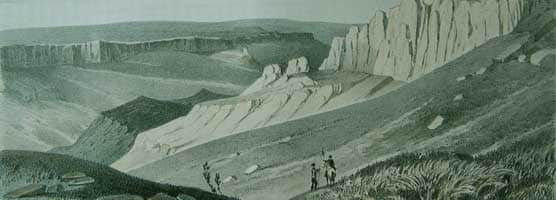
Gunnison Made The Ultimate Sacrifice
Gunnison and his men continued their explorations through the canyon. According to the National Park Service, they decided to navigate around what is now known as the Black Canyon and follow an easier route west through the present day town of Montrose.
When the expedition finally reached Utah, Gunnison witnessed the destruction left by Paiute Indian raids on Mormon settlements.
Local residents told the expedition that the attacks were not a serious threat because peace talks had just taken place. After a trip for provisions to the town of Fillmore, Gunnison divided the troops to make up for lost time.
He went ahead with a crew of soldiers and guides on October 25. His party camped along the bank of the Sevier River. The attack came during the early hours of the next morning. Only four men of his party survived.
John W. Gunnison never returned home to his family.
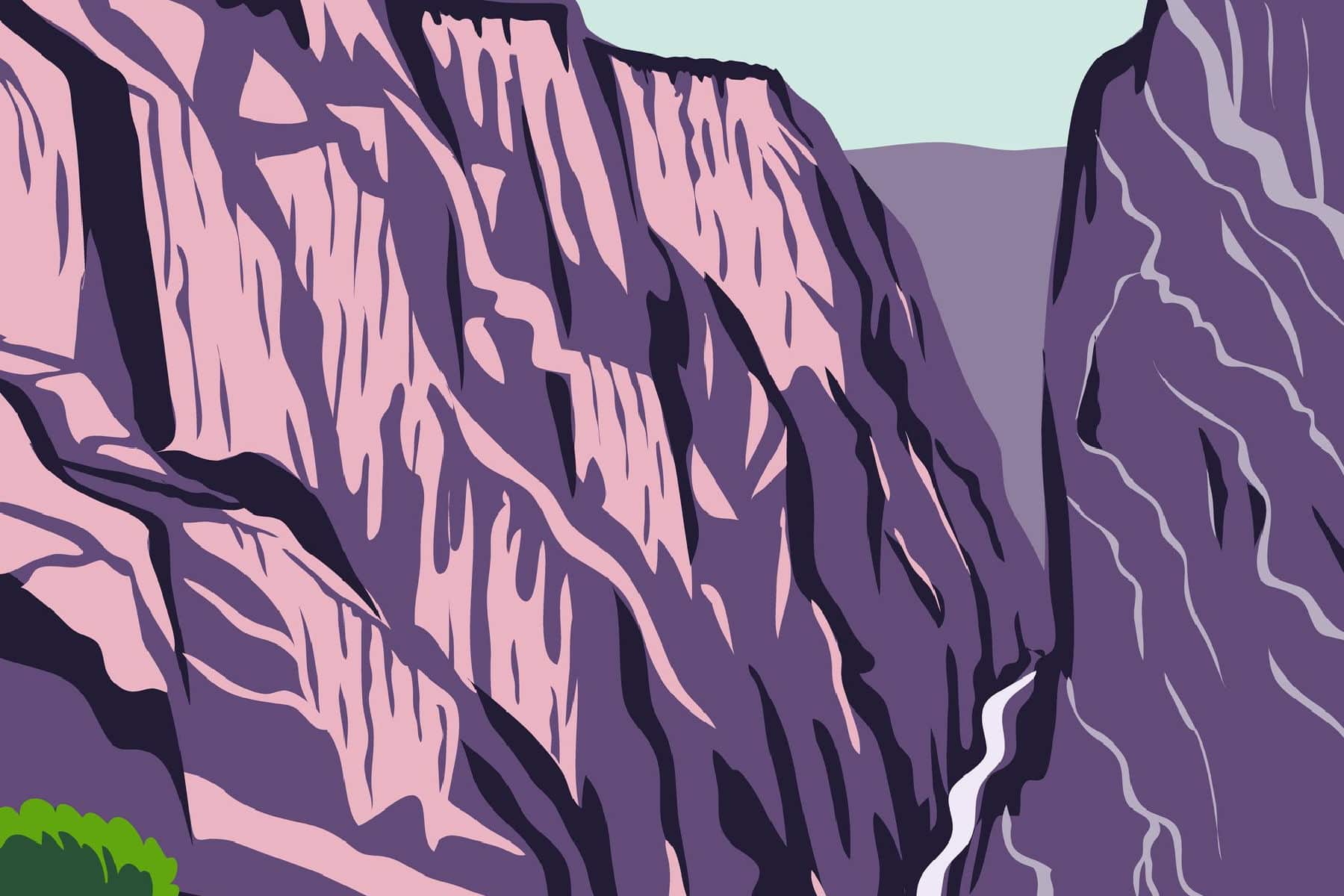
Things To Do At The Park
Here are some popular activities and things to do at Black Canyon of the Gunnison National Park:
- Hiking: There are several trails within the park that offer breathtaking views of the canyon and its surroundings. The South Rim Road offers several short hikes, including the Rim Rock Trail, which provides stunning views of the canyon.
- Scenic Drives: The South Rim Road and North Rim Road both offer scenic drives that take visitors through some of the most beautiful parts of the park.
- Rock Climbing: Black Canyon of the Gunnison is a popular destination for rock climbers, who come to scale the cliffs and explore the park’s many climbing routes.
- Wildlife Watching: The park is home to a wide variety of wildlife, including elk, mule deer, and black bears. Visitors can also see bird species like the American dipper and the Peregrine falcon.
- Camping: The park has two campgrounds, the South Rim Campground and the North Rim Campground, that offer scenic and serene camping experiences.
- Boating: The Gunnison River offers opportunities for boating and rafting, including float trips and kayaking expeditions.
- Ranger Programs: The park offers a variety of ranger-led programs, including hikes, talks, and campfire programs, that allow visitors to learn more about the park’s history, geology, and wildlife.
Whether you’re interested in hiking, wildlife watching, or simply soaking up the stunning views, Black Canyon of the Gunnison National Park has something to offer for everyone.
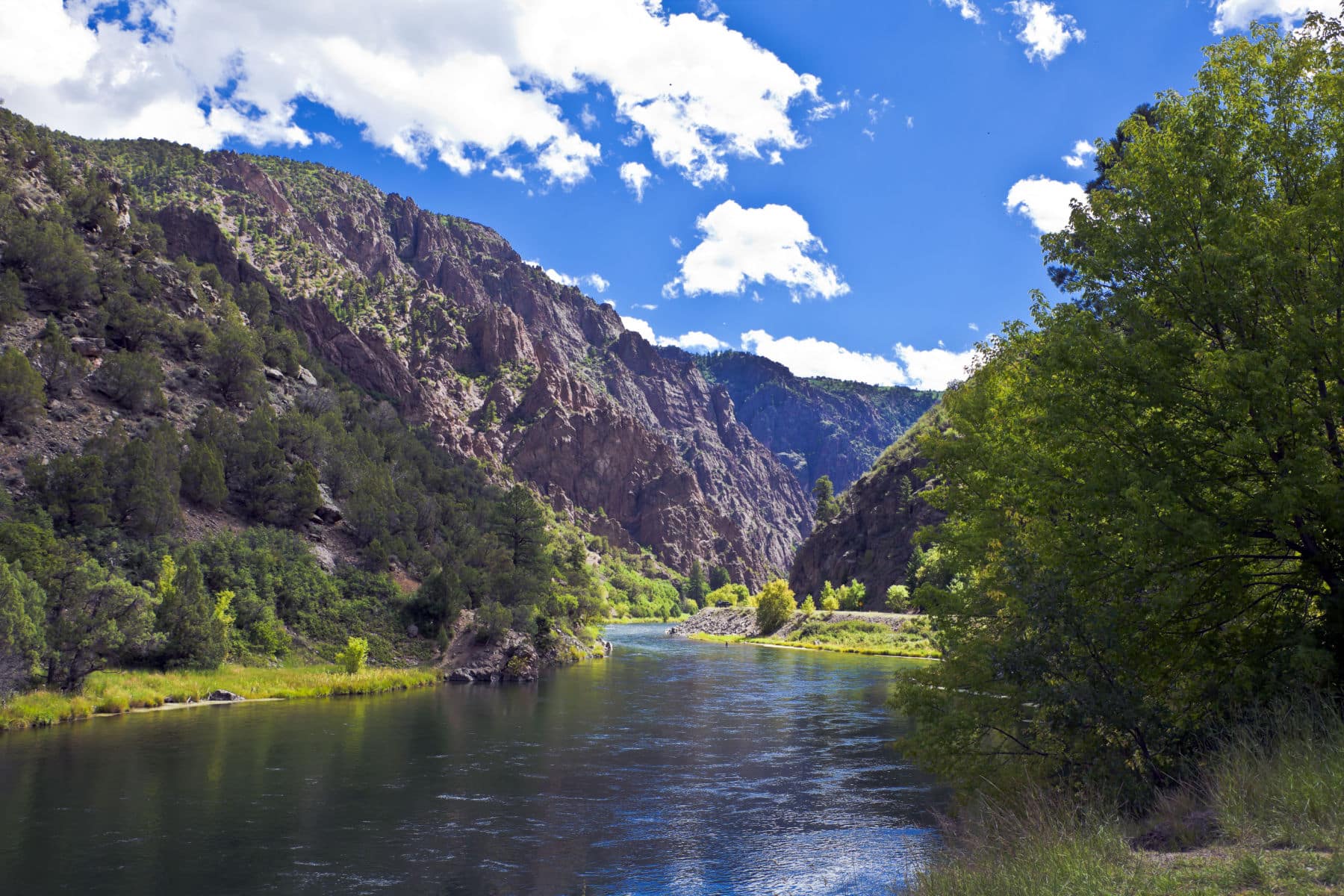
3. Garden of the Gods
Our next Colorado landmark is a registered National Natural Landmark featuring dramatic views. Visitors come to admire the 300′ sandstone rock formations against the backdrop of snow-capped Pikes Peak and brilliant blue skies.
At #3 on our list of the Best Colorado Landmarks is the Garden of the Gods.
The Garden of the Gods is a public park located in Colorado Springs. It spans over 1,300 acres and is known for its unique geological formations that are millions of years old. The park offers breathtaking views of the surrounding Rocky Mountains and is a popular destination for hikers, rock climbers, and nature enthusiasts.
The park’s most notable formations include towering red rock formations, such as the Balanced Rock, which is a 700-ton rock that appears to be precariously balanced on a narrow pedestal.
Other notable formations include the Three Graces, Cathedral Spires, and Kissing Camels. These formations are the result of erosion and geological activity that took place over millions of years.
In addition to its stunning rock formations, the Garden of the Gods is also home to a diverse range of plant and animal life. Visitors can spot a variety of wildlife, including bighorn sheep, mule deer, and coyotes.
The park also has several hiking and biking trails, picnic areas, and a visitor center where visitors can learn about the park’s history and geology.
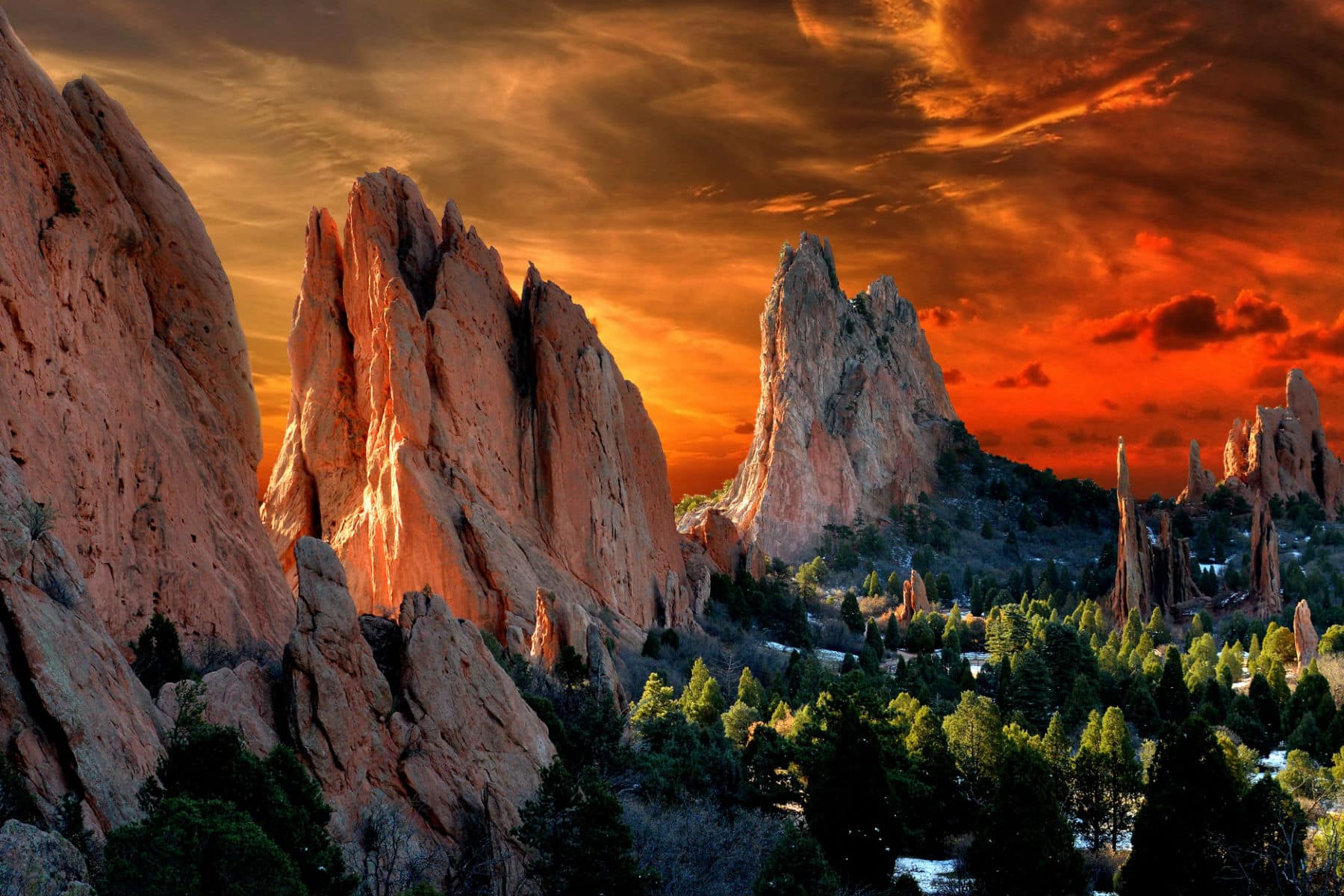
2. Pikes Peak
We’re on to our final 2 historic sites. In the runner-up spot at #2 is Pikes Peak.
Pikes Peak is a prominent mountain peak located in the Front Range of the Rocky Mountains in Colorado.
It is one of the most famous and recognizable peaks in the United States and has a rich history dating back to the early days of American exploration and settlement.
The earliest known exploration of Pikes Peak took place in 1806, when Lieutenant Zebulon Pike led an expedition to the area. Although Pike did not reach the summit, he gave the peak its name. Pikes Peak became a symbol of the American West.
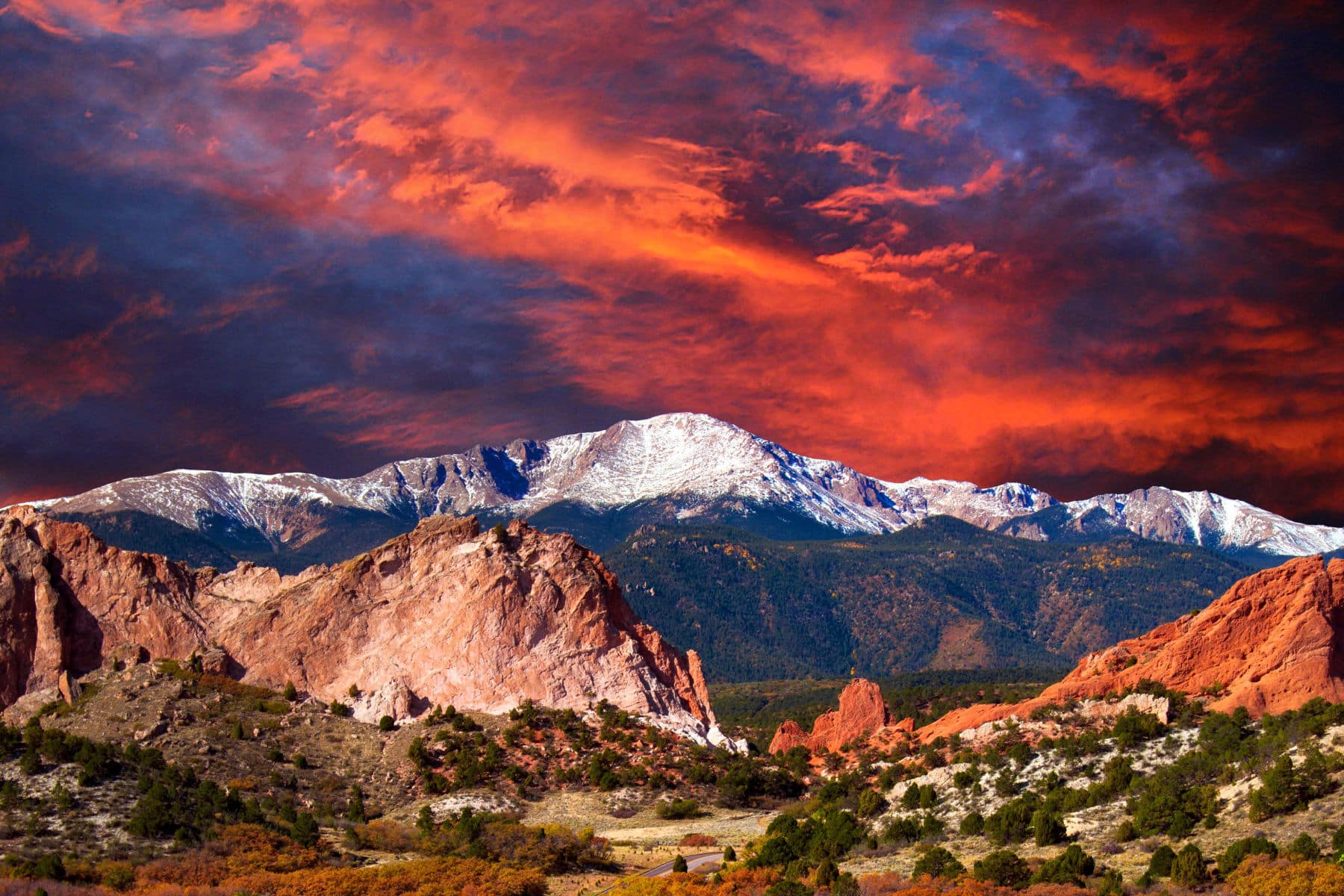
A Popular Tourist Destination
In the late 19th and early 20th centuries, Pikes Peak became a popular tourist destination, with thousands of visitors coming to the area each year to take in the stunning views from the summit. In 1916, the Pikes Peak Highway was completed, making the summit more accessible to visitors and paving the way for increased tourism.
Today, Pikes Peak is one of the most popular tourist destinations in Colorado, attracting millions of visitors each year. Visitors can drive or hike to the summit, take in the panoramic views, and enjoy a variety of recreational activities, including camping, hiking, and fishing.
Pikes Peak also holds a special place in American popular culture, inspiring numerous songs, poems, and stories over the years. Its stunning beauty and rich history make it a true American icon, and a must-visit destination for anyone traveling to the Rocky Mountains.
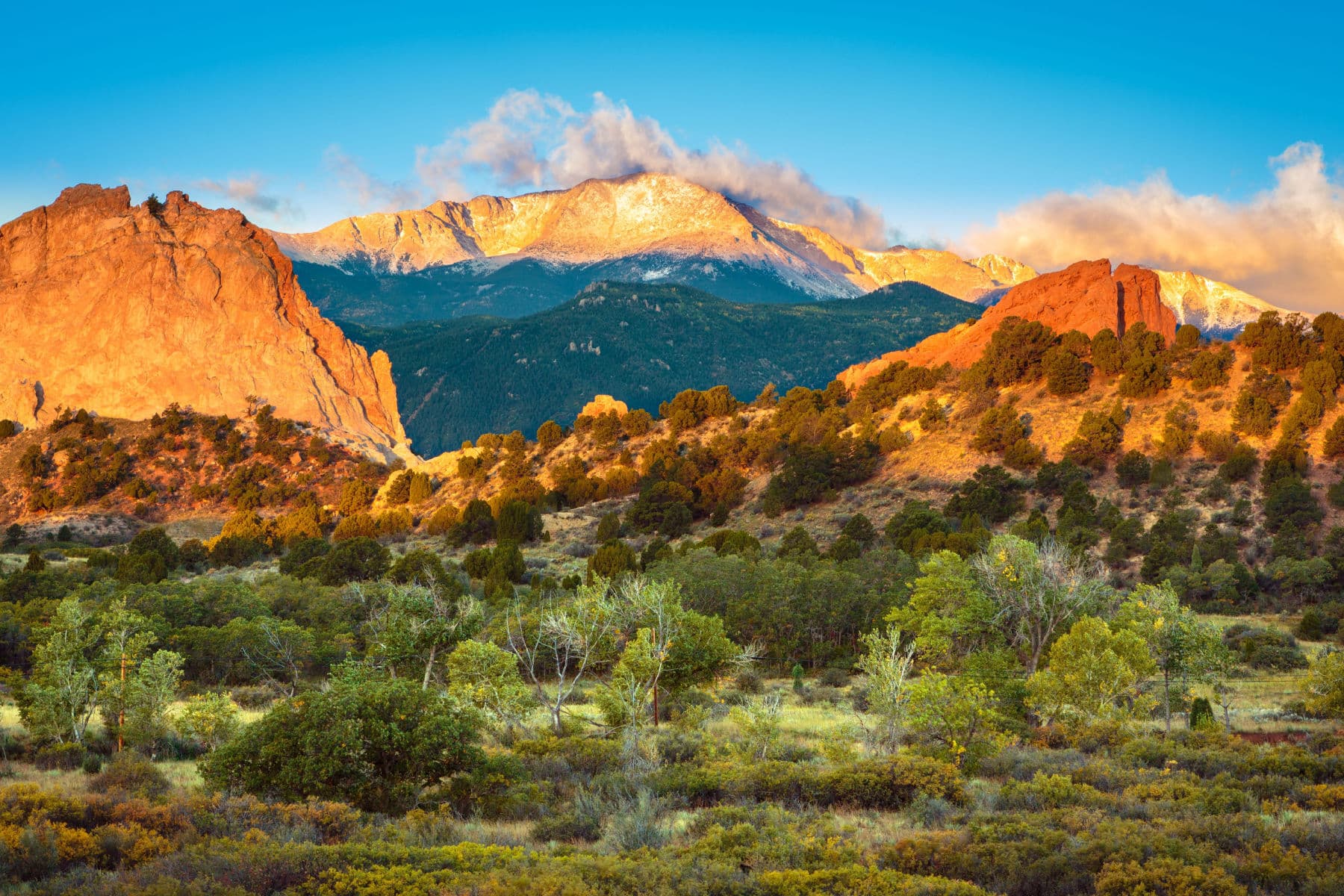
Things To Do At Pikes Peak
Visitors to the area have several options for experiencing the iconic 14,115-foot peak’s soaring heights. They include:
- Pikes Peak Train: This cherry red train takes you up 9 miles of track — pass thick conifer forests, aspen groves and more — to the top of America’s Mountain, while conductors delight with history and lore about the peak and local area.
- Pikes Peak Highway: You can travel 19 miles past the North Pole Home of Santa’s Workshop Amusement Park, a handful of reservoirs, Glen Cove Inn, picnic areas, visitors centers, scenic overlooks and interpretive areas and peekaboo moments with Pikes Peak itself.
- Cycle To The Summit: Biking the highway is also an option. Find regulations and safety tips. Worried about the uphill climb? Opt for a trip with an outfitter like Bike Pikes Peak, who will shuttle you and your bike (or provide you with one) to the top of the summit so you can enjoy the easy 7,000-foot descent.
- Hiking Trails: The most popular route for climbing to the summit is Barr Trail, a 13-mile trek with a gain of 8,000 feet in elevation that starts in Manitou Springs. Its length, high altitude, many switchbacks and unpredictable weather in any season mean only experienced and well-prepared hikers (warm clothing, plenty of water and food) should attempt the full route to the summit.
- Garden Of The Gods: The view of Pikes Peak from the balcony of the Garden of the Gods Visitor Center in Colorado Springs is one of the best. The free attraction’s red-sandstone formations frame the peak spectacularly, surely one of the reasons the park has been named a National Natural Landmark. (Source: Come To Life Colorado)

1. Mesa Verde National Park
As the #1 Colorado Landmark, More Than Just Parks has selected Mesa Verde National Park.
Mesa Verde is a sacred place. As the National Park Service notes, for over 700 years, the Ancestral Pueblo people built thriving communities on the mesas and in the cliffs of Mesa Verde.
Today, the park protects the rich cultural heritage of 26 Pueblos and Tribes and offers visitors a spectacular window into the past.
This World Heritage Site and International Dark Sky Park is home to over a thousand species, including several that live nowhere else on earth.
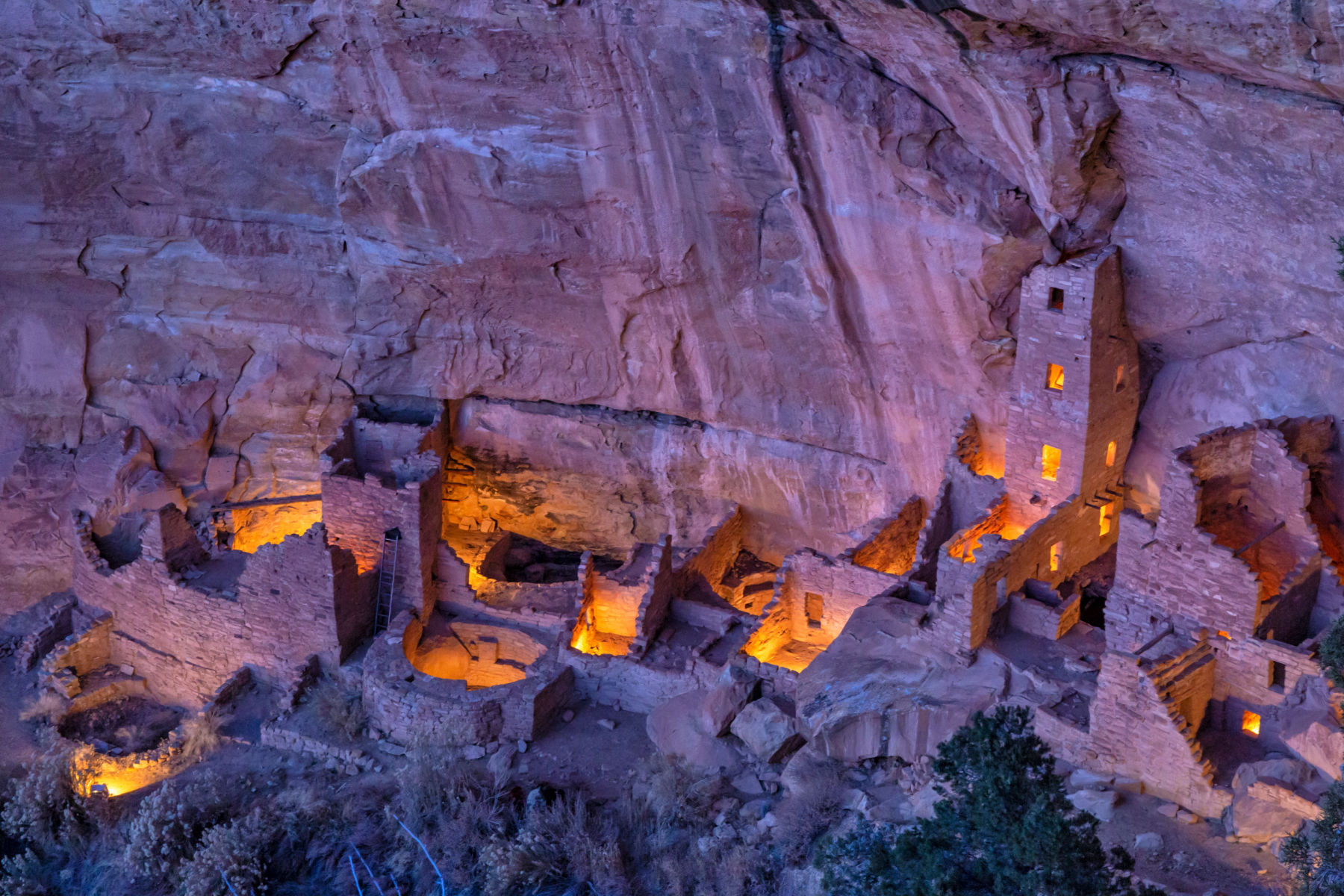
The Cliff Dwellings At Mesa Verde
The cliff dwellings at Mesa Verde are a series of ancient dwellings and communities built into the cliffs and alcoves of Mesa Verde. They were built by the Ancestral Pueblo people, who lived in the area from 600 to 1300 AD.
The cliff dwellings at Mesa Verde are considered to be some of the most well-preserved and impressive examples of ancient Pueblo architecture in the United States. They are remarkable not only for their architectural design, but also for the sheer size and scale of the structures, many of which contain dozens of rooms and multiple stories.
The Ancestral Pueblo people who built the cliff dwellings at Mesa Verde are thought to have been farmers who lived in the area for generations, cultivating crops and raising families. The cliff dwellings were likely built as a form of defensive architecture, offering protection from enemies and the elements.
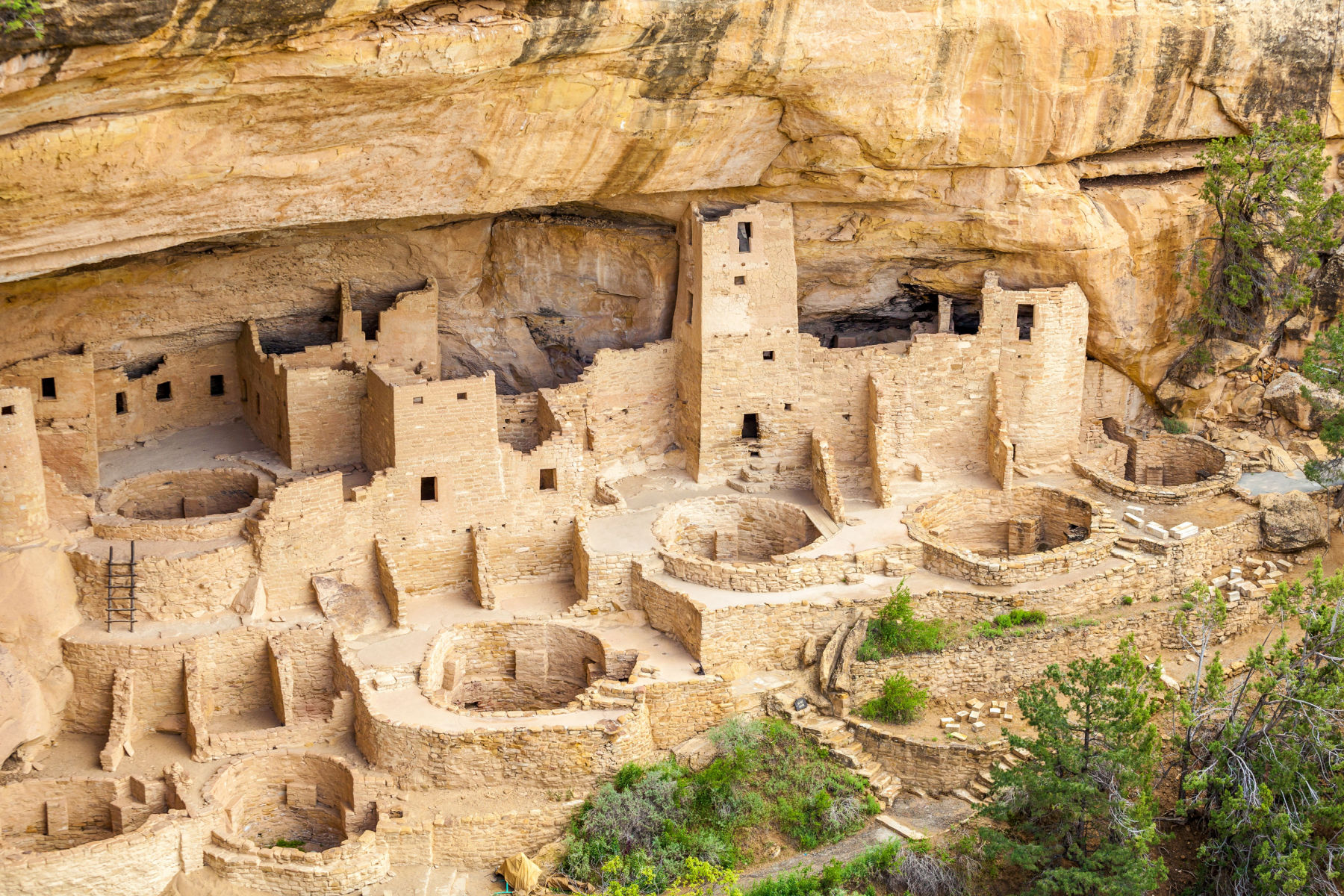
It’s A Popular Tourist Attraction Today
Today, the cliff dwellings at Mesa Verde are a popular tourist destination, attracting visitors from around the world to see the ancient structures and learn about the lives of the Ancestral Pueblo people.
Visitors can take guided tours of several of the most well-preserved cliff dwellings, including the famous Cliff Palace, which contains over 150 rooms and is considered one of the largest cliff dwellings in the world.
The cliff dwellings at Mesa Verde are a unique and fascinating piece of American history, offering a glimpse into the lives of the Ancestral Pueblo people and the rich cultural heritage of the southwestern United States.

Spruce Tree House is the best preserved cliff dwelling in the Mesa Verde National Park. It is the third largest cliff dwelling behind Cliff Palace and Long House and was constructed sometime between 1211 and 1278. The dwelling has around 130 rooms and 8 kivas and was estimated to be the home to around 60 to 80 people.
The cliff dwelling was first discovered in 1888, when two local ranchers chanced upon it while searching for stray cattle.
A large tree, which they identified as a Douglas Spruce (later called Douglas Fir), was found growing from the front of the dwelling to the mesa top. It is said that the men first entered the dwelling by climbing down this tree, which was later cut down by another early explorer.
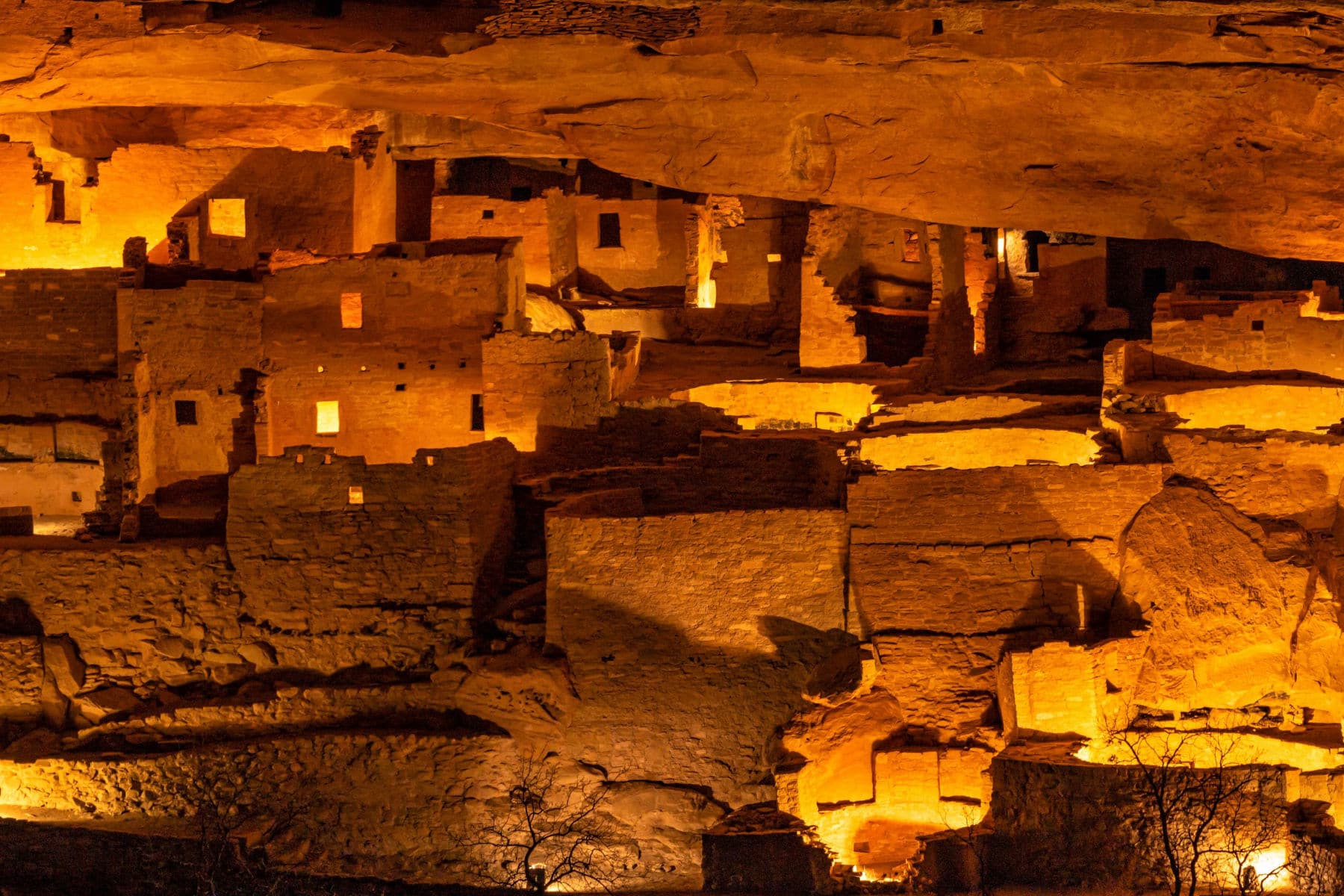
Map Of Colorado Landmarks
List Of Colorado Landmarks
- Mesa Verde National Park
- Pikes Peak
- Garden of the Gods
- Black Canyon of the Gunnison National Park
- United States Air Force Academy
- Great Sand Dunes National Park and Preserve
- Granada War Relocation Center
- Dinosaur National Monument
- Sand Creek Massacre National Historic Site
- Canyon of the Ancients National Monument
- Red Rocks Park and Amphitheater
- Florissant Fossil Beds National Monument
- Bent’s Old Fort National Historic Site
- Philadelphia Toboggan Company Carousel No. 6
- Hovenweep National Monument
- Molly Brown House Museum
- Durango & Silverton Narrow Gauge Railroad
- Shenandoah-Dives Mill
- Indian Springs Trace Fossil Natural Area
- Ludlow Tent Colony Site
Why Trust Us About Colorado Landmarks?
We’re Jim Pattiz and Will Pattiz, collectively known as the Pattiz Brothers and we absolutely LOVE the national parks.
You should probably know that we don’t just make this stuff up out of thin air. We’ve spent our entire adult lives exploring and filming America’s national parks and public lands.
We’ve worked with the National Park Service, the Department of Interior, USDA, U.S. Forest Service, and more for years creating films on important places and issues. Our work has been featured in leading publications all over the world and even some people outside of our immediate family call us experts on the national parks.
And, in 2018, our father – having spent a lifetime teaching history – joined us so that he could help us to tell the stories behind these amazing places.
Meet The Parks Brothers
We Hope You’ll Follow Our Journey

Our goal here at More Than Just Parks is to share the beauty of America’s national parks and public lands through stunning short films in an effort to get Americans and the world to see the true value in land conservation.
We hope you’ll follow our journey through the parks and help us to keep them the incredible places that they are. If you’re interested joining the adventure, sign up below!
Helpful Articles
Rocky Mountain NP Guide: Expert Guide to Rocky Mountain National Park
Things to Do Rocky Mountain: 15 EPIC Things to Do Rocky Mountain National Park
Best Hikes Rocky Mountain: 18 EPIC Hikes Rocky Mountain National Park
Zion National Park Guide: Ultimate Guide to Zion National Park
Things to Do in Zion: 18 EPIC Things to Do in Zion National Park
Best Hikes in Zion: 16 EPIC Hikes in Zion National Park
Things to Do in Arches: 16 EPIC Things to Do in Arches National Park
Utah National Parks Guide: 5 MIGHTY Utah National Parks Guide
Utah National Parks Road Trips: 5 Best Utah National Park Road Trips
National Parks Rankings: ALL 63 US National Parks Ranked By Experts
Most Visited National Parks: Top 10 Most Visited National Parks
Least Visited National Parks: Top 10 Least Visited National Parks
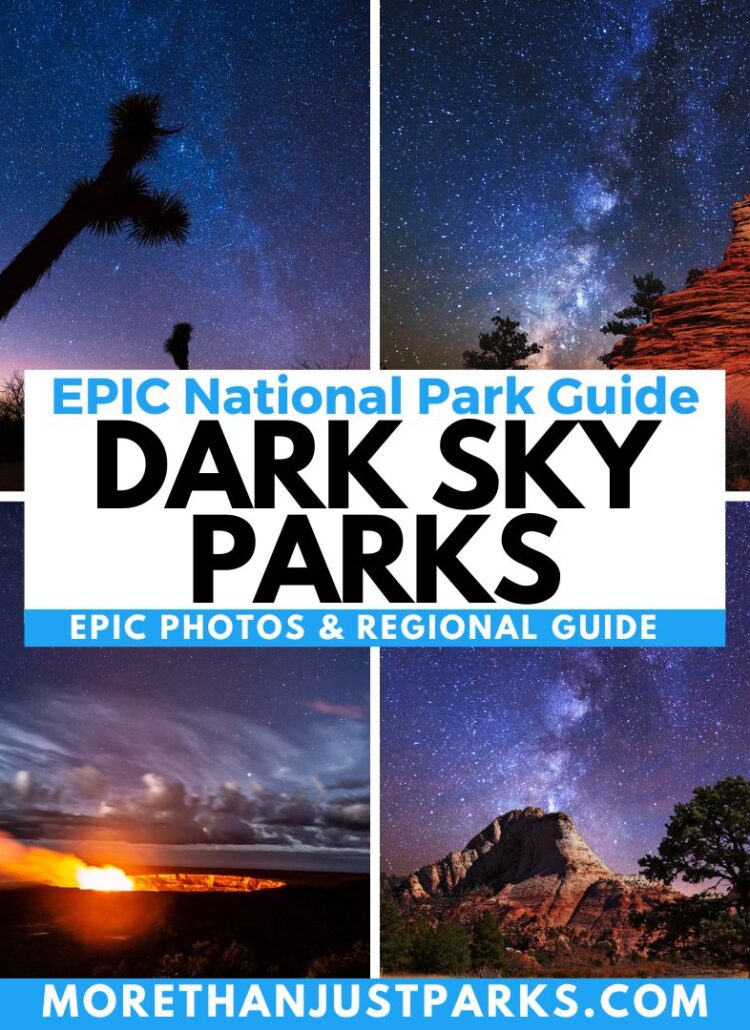
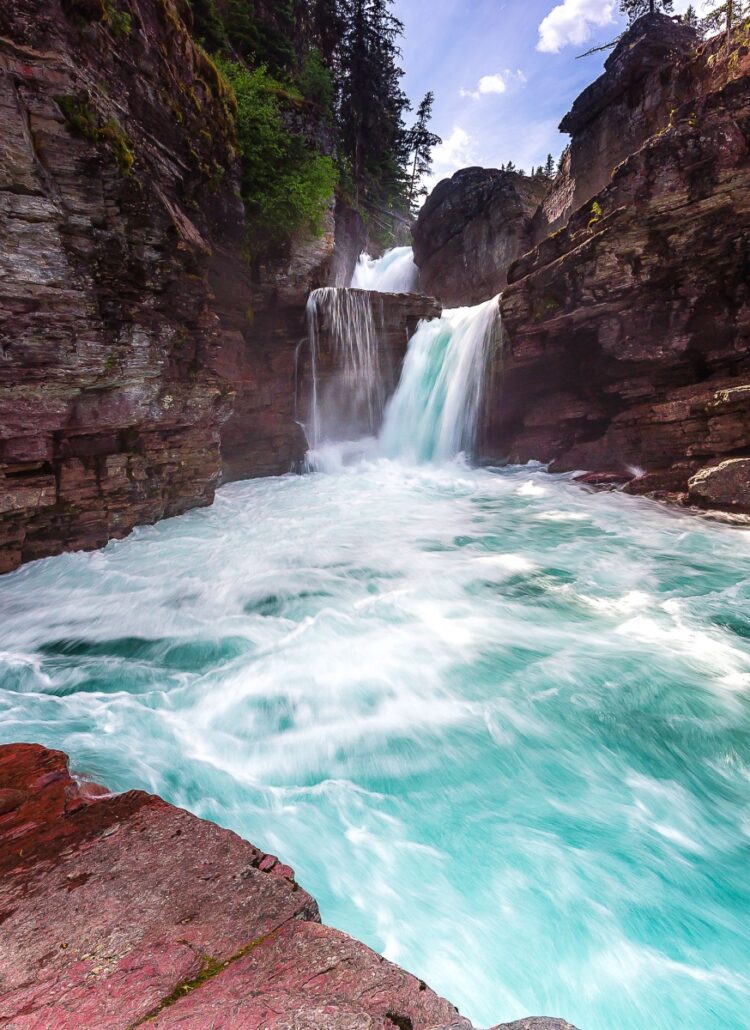
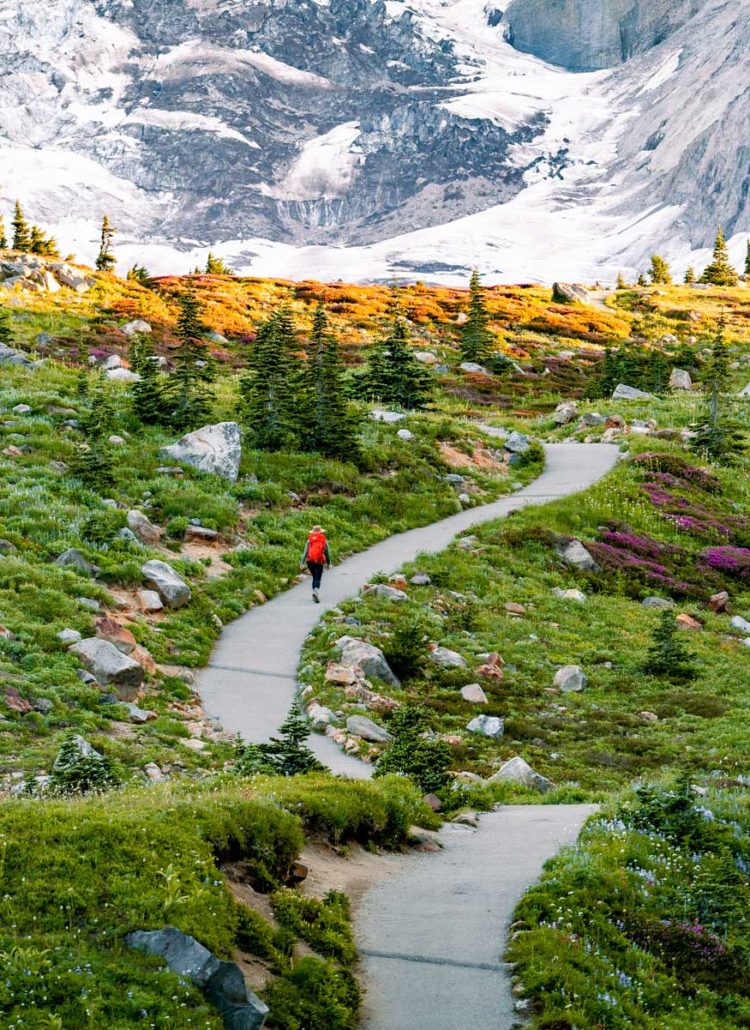


Leave a Reply